1 How We Pay for the Public Sector
WHERE THE MONEY COMES FROM AND WHERE IT GOES
Managers need to know where public money comes from and where it goes. That information can answer important questions like:
- What revenue options are available to governments? Non-profits?
- What are the advantages and disadvantages of various revenue sources with respect to efficiency, equity, fairness, and other goals?
- How will the US federal government’s financial challenges shape the financial future of the public sector?
- How, if at all, will governments address the challenges of income and racial inequality?
In January 2010, the United States Department of Justice (DOJ) received a formal civil rights complaint from a local community organization in Ferguson, Missouri. In their complaint, they accused the Ferguson Police Department of aggressive and biased policing tactics, including large numbers of traffic stops, searches, seizures, and arrests in the city’s African American communities. DOJ officials corroborated the report with the Missouri Attorney General’s office, which had also received several similar complaints throughout the previous five years. Both offices agreed to monitor the situation.
On August 9, 2014, Michael Brown, an African American teenager, and resident of Ferguson, was shot and killed by a Ferguson police officer who was investigating a nearby robbery. Ferguson police officials drew sharp criticism for the incident and their management of the subsequent investigation into potential police misconduct. Several weeks later, a grand jury declined to indict the police officer. In their view, the evidence suggested the police officer had reason enough to consider Brown as a potentially dangerous suspect.
The shooting sparked violent protests across the United States. Ferguson residents said the shooting was just the most recent example of the racist policing they had pointed out to federal and state officials years earlier. They implored Attorney General Eric Holder to immediately open a DOJ civil rights investigation into the Ferguson Police Department. Holder said his office would gather as much information as possible but cautioned everyone that anecdotes and demographics are insufficient to prove an accusation of biased policing. For several weeks, the country anxiously awaited word on what DOJ would do next.
On September 20, 2014, the DOJ opened a formal civil rights investigation. The report from that investigation was released in March 2015. It excoriated the Ferguson Police Department and the Ferguson City Council for actively and passively encouraging the sort of aggressive policing that Ferguson residents had decried. But perhaps even more importantly, it explained that the most compelling evidence of biased policing was not arrest records or police reports. It was Ferguson’s budget. The report said, “Ferguson’s law enforcement practices are shaped by the City’s focus on revenue rather than public safety needs.” It documented a recent trend toward raising new city revenues through aggressive enforcement of fines and fees. Ferguson generated more than $2.5 million in municipal court revenue in fiscal year 2013, an 80 percent increase from only two years prior. In all, fines and forfeitures comprised 20 percent of the city’s operating revenue in fiscal year 2013, up from about 13 percent in 2011. By comparison, other St. Louis suburbs relied on fines and fees for no more than six percent of operating revenue. This budget strategy legitimized and even encouraged Ferguson’s law enforcement and court officials, most of whom were not racists, to pursue aggressive policing against Ferguson’s majority African American community.
The takeaway here is clear: where a public organization gets its money says a lot about its priorities. In Ferguson’s case, choices about where to get revenue led to a nationwide social movement.
LEARNING OBJECTIVES
After reading this chapter, you should be able to:
- Identify the revenue sources used by the federal, state, and local governments.
- Show how similar governments pay for similar services in quite different ways.
- Identify some of the “macro-challenges” that will shape public organizations’ finances well into the future.
Governments across the United States do the same basic things. Cities and towns primarily maintain roads, plow snow, keep neighborhoods safe, prevent and fight fires, and educate children. County governments run elections, care for the mentally ill, and prevent infectious diseases. State governments provide schools with funding for education, coordinate health care for the poor, incarcerate prisoners, and operate public universities and community colleges. The national – or “federal” – government regulates trade and commerce, defends our borders, and pays for health care for seniors.
At the same time, governments are remarkably dissimilar in how they pay for and deliver these services. Some rely on a single tax source for most or all of their revenue. Others draw on many different revenue sources. Some deliver their services with the help of non-profits, private sector contractors, and other stakeholders. Others engage outside entities infrequently, if at all. Some citizens want their government to deliver many different high-quality services. Others want their government to do as little as possible.
These choices about how governments pay for their services, how much they provide, and how they ultimately deliver those services matter a lot to citizens. For instance, if a city government depends mostly on property taxes, its leaders might have the incentive to emphasize services that benefit property owners, such as public safety and sidewalks, and worry less about services more likely to benefit those who do not own property, like public parks or housing people experiencing homelessness. In some regions, governments pay non-profit organizations to deliver most or all essential services in areas like foster care, child immunizations, and assisted living for seniors. For those who use those services, the quality of service they receive can depend a lot on which non-profit delivers the service or manages their case.
So, at a high level, governments look the same. But if we examine them more carefully, we see they vary greatly in where their money comes from and where it goes. That variation, and its implications for citizens, is a key part of the study of public finance. This chapter is a basic overview of where governments get their money, where they spend it, and some of the financial challenges they will likely face.
THE FEDERAL GOVERNMENT
The national government – also known as the “federal government” – is one of the largest and most important employers in the United States. Every soldier in the military, customs agent at an airport, and astronaut at NASA (the National Aeronautics and Space Administration’s acronym) works for the federal government. And so do many, many others. In 2022, the federal government spent just under $6.3 trillion and employed an estimated 4.3 million people directly and millions indirectly as government contractors and grant employees. For the past decade or so, federal government spending has accounted for roughly one-quarter of the U.S.’s entire economic output – otherwise known as its gross domestic product (GDP).
Federal government revenues in FY 2022 were $4.9 trillion; 84 percent was from two sources –individual income tax and payroll taxes.
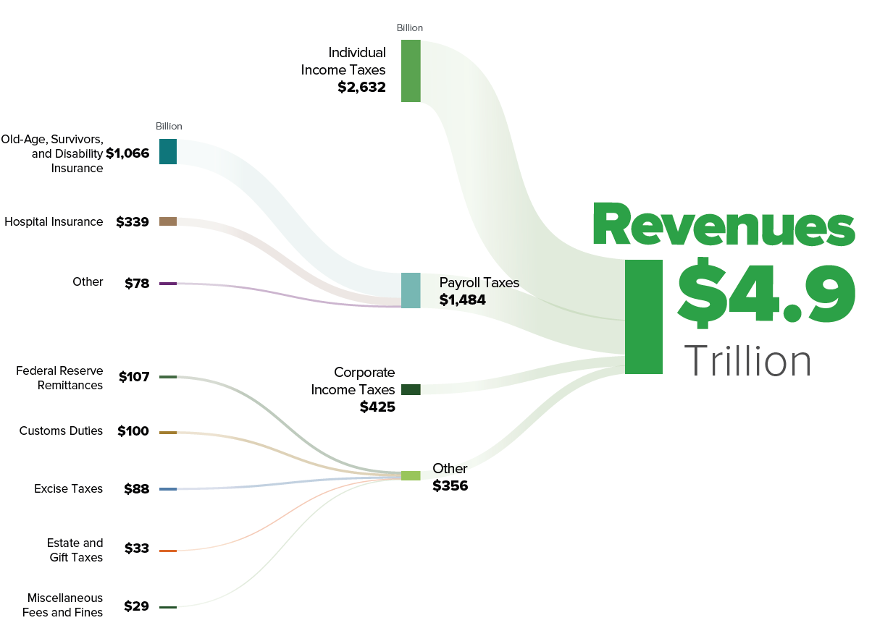
The federal government collected just over $2.6 trillion in individual income taxes in FY 2022. The tax paid on income is determined by applying a tax rate to taxable income with allowances for tax preferences.
Taxable income is the amount of income (e.g., wages, interest and dividend income, partnership and business income (or loss), farm income, pension income, rents, royalties, and Social Security benefits) subject to tax after deductions and exemptions. The federal government offers a standard deduction that all taxpayers can claim. The reduction of taxable income varies by filer type (e.g., $13,850 for single filers, $27,700 for married filers filing jointly, and $20,800 for heads of household in 2023). Beyond that standard deduction, eligible taxpayers can claim hundreds of other exemptions, deductions, credits, and other tax benefits related to home ownership, retirement savings, health insurance, investments in equipment and technology, and dozens of other areas. The federal government offers these preferences to encourage taxpayers to save for retirement, buy a home, invest in a business, or participate in other types of economic activity. The tax rate is the amount of tax paid per dollar of taxable income. For 2023, the federal tax code has seven different rates that are applied across levels of taxable income (also known as tax brackets). Those statutory rates ranged from 10 percent on individual annual income up to $11,000 to 37 percent on annual income over $578,125 ($693,750 for married individuals filing joint returns).
| Statutory Tax Rate | For Single Filers | For Married, Joint Returns | For Heads of Households |
| 10% | $ – to $11,000 | $ – to $22,000 | $ – to $15,700 |
| 12% | $11,000 to $44,725 | $22,000 to $89,450 | $15,700 to $59,850 |
| 22% | $44,725 to $95,375 | $89,450 to $190,750 | $59,850 to $95,350 |
| 24% | $95,375 to $182,100 | $190,750 to $364,200 | $95,350 to $182,100 |
| 32% | $182,100 to $231,250 | $364,200 to $462,500 | $182,100 to $231,250 |
| 35% | $231,250 to $578,125 | $462,500 to $693,750 | $231,250 to $578,100 |
| 37% | $578,125 to or more | $693,750 to or more | $578,100 to or more |
When an individual uses exemptions, deductions, and credits, their effective tax rate (ETR, i.e., tax liability divided by their taxable income) is frequently lower than the marginal tax rate (i.e., the statutory tax rate imposed on the last dollar of income). For that reason, the debate on tax policy is focused on the effective tax rate, not the marginal tax rate.
Social insurance receipts are taxes levied on individuals’ wages. Employers and employees contribute an equal amount in Old-Age, Survivors, and Disability Insurance (OASDI) tax equal to 6.2 percent of gross income up to $160,200 and an additional 1.45 percent in Hospital Insurance (HI), proceeds of which are used to fund the federal Medicare program. That is why they are referred to as payroll taxes or withholding taxes. In FY 2022, payroll taxes were $1.48 trillion.
While the income tax is progressive, payroll taxes are regressive, with the highest average rate falling on Americans with the lowest income. For example, the estimated payroll tax burden for individuals making less than $50,000 is between 9.1 and 10.9 percent, while the average payroll tax burden for individuals making more than $500,000 was 5.4 percent – 1.9 percent for those making $1 million or more.
Average or Effective Income and Payroll Tax Rates by Income Group
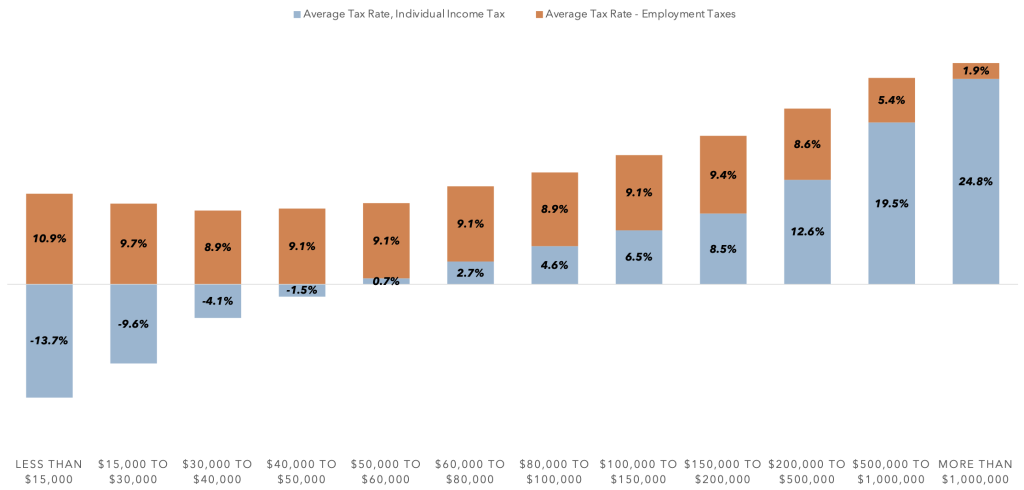
There has been a lot of debate surrounding the 47 percent of taxpayers who do not pay federal income taxes. That is correct – 47 percent of taxpayers don’t pay federal income taxes. But that is by design! The income tax rates are low for low-income households. Coupled with deductions, exemptions, and tax credits (e.g., the child tax credit and earned income tax credit) –47 percent of taxpayers do not pay federal income taxes. They do, however, pay payroll taxes, state income taxes, sales taxes, property taxes, and taxes on gasoline, alcohol, and tobacco. Adjusting for state and local taxes, the U.S. tax system as a whole is, in fact, regressive.
What is frequently overlooked in the debate about the 47 percent is their share of income. The Joint Committee on Taxation estimates the 47 percent that did not pay federal income taxes earned 13 percent of total income. Sixty-six percent of total income is earned by the top 25 percent of tax filers (i.e., those reporting an annual income greater than $100,000).[1] And while the effective (or average) income tax rates are higher for these filers, the economic value of their tax preferences – the value of their deductions, exclusions, exemptions, and preferential tax rates – far exceed direct government spending (e.g., Medicare, Medicaid, and Social Security) for those that do not pay federal income tax. Wealth inequality is even greater. The top 10 percent of households – those with at least $1.2 million in net worth – own in aggregate 77 percent of the wealth in America, whereas the bottom half of families (approximately 63 million families reporting a net worth of $97,000 or less) own in aggregate one percent of the wealth (Source: Ana Kent, Lowell Ricketts, and Ray Boshara “What Wealth Inequality in America Looks Like: Key Facts & Figures” Federal Reserve Bank of St. Louis).
Suzanne Mettler, author of The Government-Citizen Disconnect, notes that the assumption that the welfare state serves low-income households is, in fact, false. We are all beneficiaries! What differentiates the 47 percent from everyone else is the visibility of government programs, services, and policies. Low-income households rely on government programs that make the government’s role most apparent. The high-income households benefit from tax preferences that obscure the government’s role and, as such, are not viewed as spending because appropriations are not made, and benefits checks are not sent.
The remaining 16 percent of federal revenue ($781 billion) was from a variety of sources, including the corporate income tax (taxes on business income rather than individual income), excise taxes (taxes on the purchase of specific goods like gasoline, cigarettes, and airline tickets), and estate taxes (a tax imposed when a family’s wealth is transferred from one generation to the next).
As shown in the figure below, revenues from corporate income tax, excise taxes, and estate taxes have either remained constant or declined as a share of GDP. In fact, growth in federal government revenues is primarily from the personal income tax, and much of that growth is driven by economic expansion as the top marginal income tax rates have declined from 91 percent on income in excess of $200,000 in 1962 (or $400,000 filing jointly) to 37 percent in 2020.[2] The federal income tax is less progressive today than it was in 1962 when the government had 20 income tax brackets.
Federal Government Revenues (% of GDP)
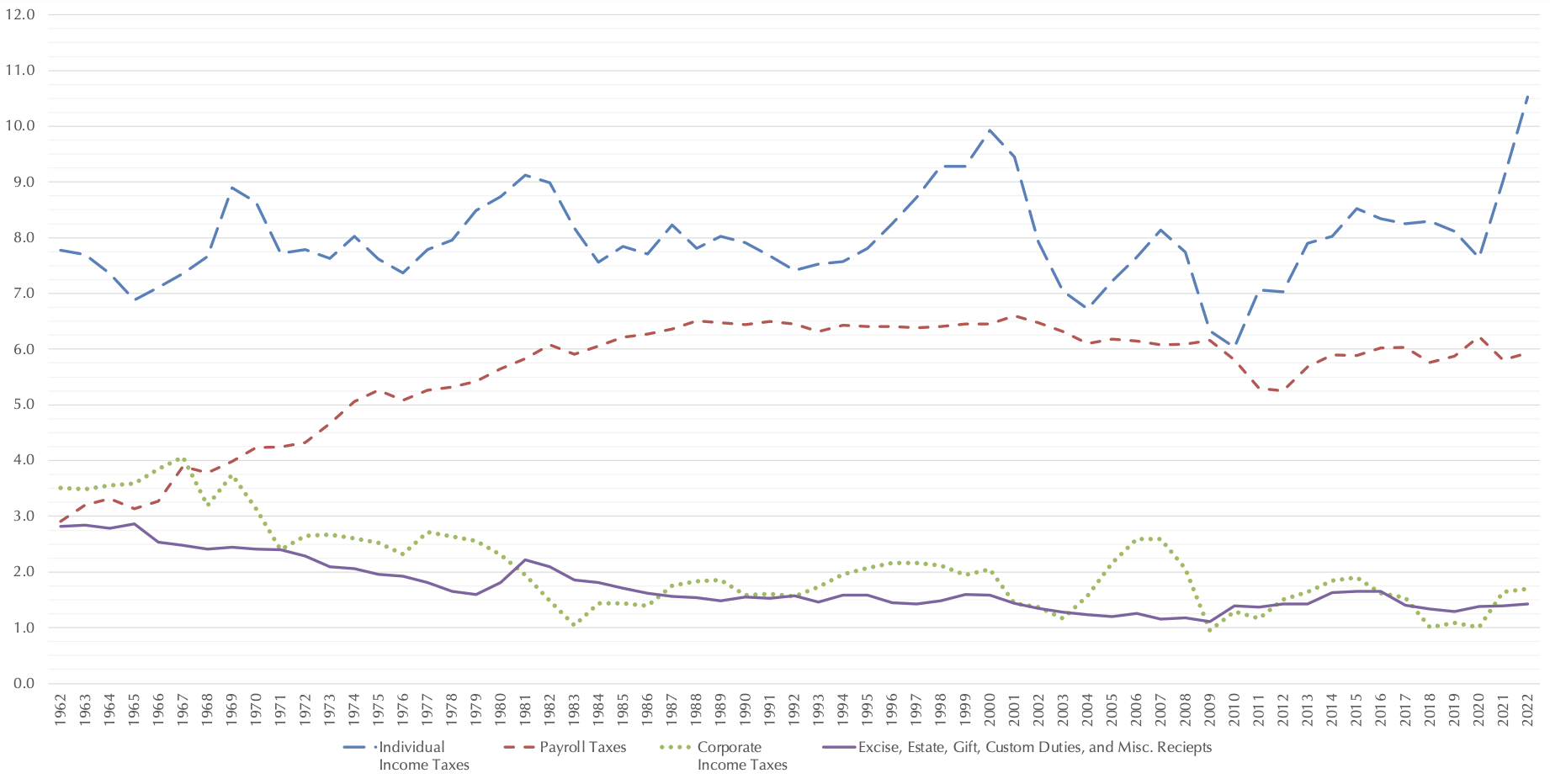
TAX PREFERENCES: SPENDING BY ANOTHER NAME
Tax preferences – sometimes called tax expenditures – are provisions in tax law that allow preferential treatment of certain taxpayers. They include exclusions, exemptions, deductions, preferential tax rates, credits, deferrals, and anything else to reduce an individual’s or a corporation’s tax liability.
Exclusions, exemptions, and deductions reduce the amount of income subject to tax. Employer contributions to pension plans and employer-sponsored health care plans are excluded from the federal and state income tax. Itemized deductions are a special category of deductions, valuable only to taxpayers whose itemized deductions exceed the standard deduction. Itemized deductions are most valuable to high-income earners whose annual mortgage interest cost, state and local tax (SALT) deduction, and charitable contributions exceed the standard deduction. High-income earners are also more likely to invest in municipal bonds. Interest income from municipal debt is exempt from federal taxes. Credits reduce tax liability dollar for dollar by the amount of credit. Examples include the earned income tax credit (EITC) and child tax credit. Preferential tax rates benefit taxpayers who receive certain income. Income earned from capital gains and dividends, for example, are taxed at preferential rates that are significantly lower than the income tax rates. Deferrals allow taxpayers to delay payments without penalty. The federal government defers tax payments on income earned in qualified retirement plans. Payments are only required when beneficiaries withdraw assets from their retirement plans.
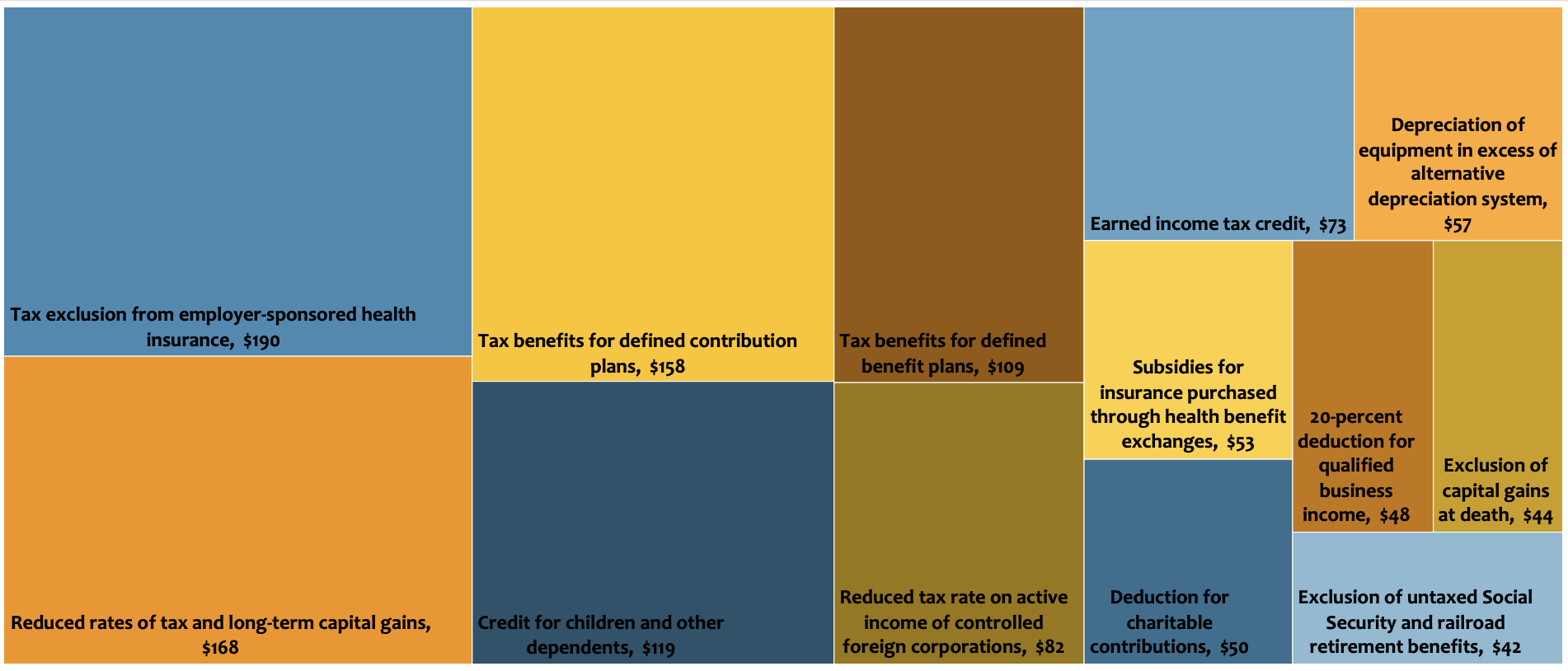
Tax expenditures are, in effect, a form of spending. They are also costly. For comparison, the cost of all federal income tax expenditures is higher than Social Security and the combined cost of Medicare and Medicaid. They also exceed the combined cost of defense and non-defense discretionary spending.
Additionally, exclusions, exemptions, deductions, preferential tax rates, credits, and deferrals increase as household income rises. Put differently, these subsidies benefit individuals that do not need them, further exacerbating racial disparities in income and wealth. The child tax credit ($119 billion) and earned income tax credit ($73 billion) are exceptions.
The 2017 Tax Cuts and Jobs Act did not advance racial equity in the federal tax code. In fact, core provisions tilt heavily towards households at the top of the income distribution. Analysis shows the highest-income (predominately white) households receive 23.7 percent of the TCJA tax cuts, far more than the 13.8 percent of tax cuts that go to the bottom 60 percent of households (of all races).
Sources: Center for Budget and Policy Priorities (2019) “Policy Basics: Federal Tax Expenditures” and Chye-Ching Huang and Roderick Taylor (2019) “How the Federal Tax Code Can Better Advance Racial Equity: 2017 Tax Law Took Step Backward” Center for Budget and Policy Priorities.
We often divide federal government spending into two categories: discretionary and non-discretionary spending, the latter of which is sometimes referred to as mandatory spending. Non-discretionary spending is controlled by law. Social Security is a good example. A person becomes eligible for “full” Social Security benefits once they are over the age of 65 and have paid payroll taxes for almost four years. Once they become eligible, their benefit is determined by a formula linked to the total wages earned during their last 35 years of employment. That formula is written into the law that created Social Security. Once a person becomes eligible, they are “entitled” to the benefits determined by that formula. Other programs like Medicare, food stamps, Supplemental Security Income, and many others follow a formula-based structure. If Congress and the President want to change how much is spent on these programs, they must change the relevant laws.
Discretionary spending includes appropriations for national defense and federal government agencies. This is spending that Congress and the President can adjust in the annual budget. In fact, the vast majority of federal spending is driven by laws, rules, and priorities that originate outside the budget. Data shows that non-discretionary spending is more than 65 percent of all federal spending. Add to those monies spent on interest on the national debt (roughly 7-8 percent), and we see that nearly three-quarters of federal spending is “locked in.” So, when Congress debates its annual budget, they are, in effect, debating on about 10 to 25 percent of what it will eventually spend.
Federal Government Outlays (% of GDP)
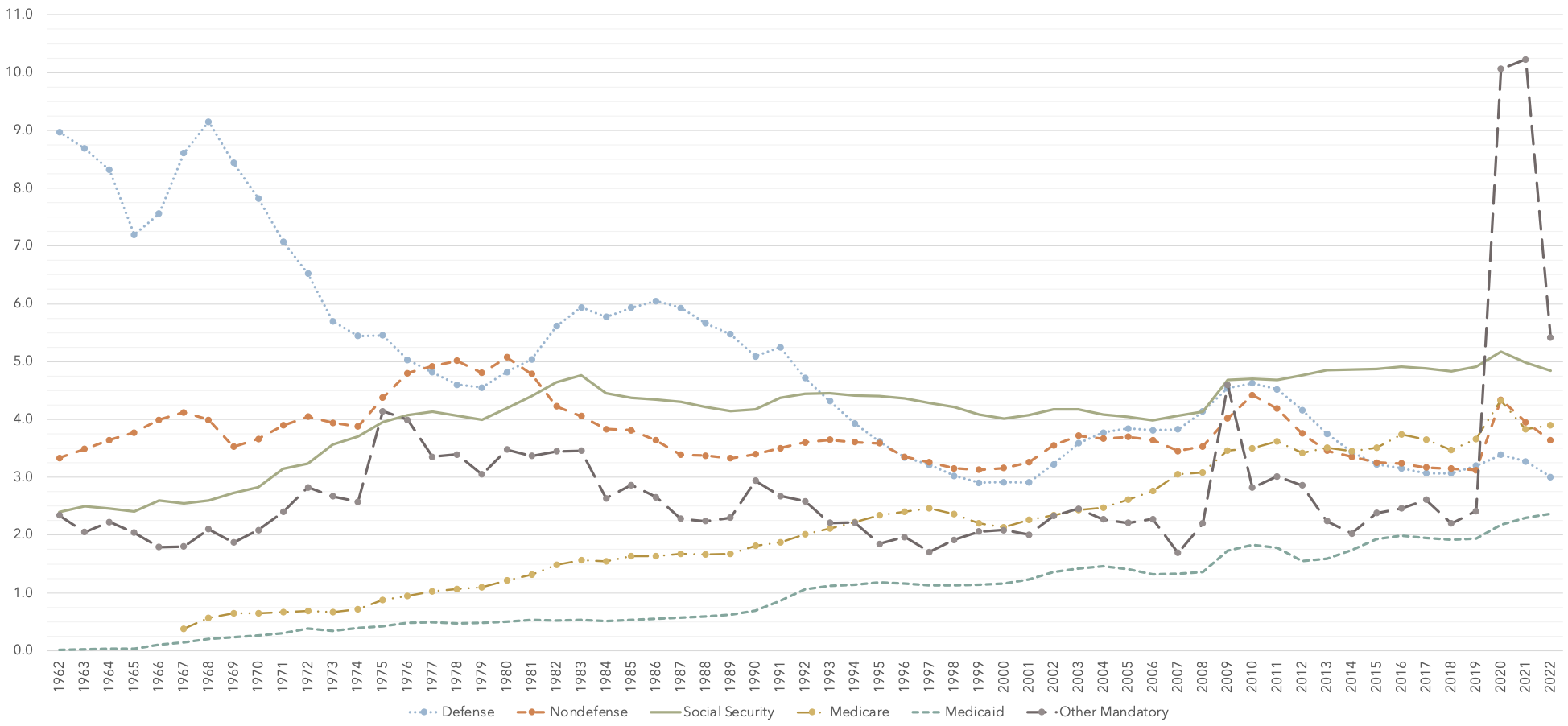
In 2022, federal spending on mandatory programs was $4.1 trillion. That included $1.2 trillion in social security benefits, $1.4 trillion in healthcare spending (primarily Medicare and Medicaid), $581 billion in income security programs (unemployment compensation, earned income tax credits, supplemental nutrition assistance programs, etc.), and $348 billion in federal civilian and military retirement benefits and other veterans’ programs.
The federal government spent $1.4 trillion on healthcare, including Medicare and Medicaid. Federal spending in these two programs represents 37 cents of every dollar spent on health care in the U.S. – more than private insurance (33 percent), out-of-pocket expenses (10 percent), or any other government program (20 percent).
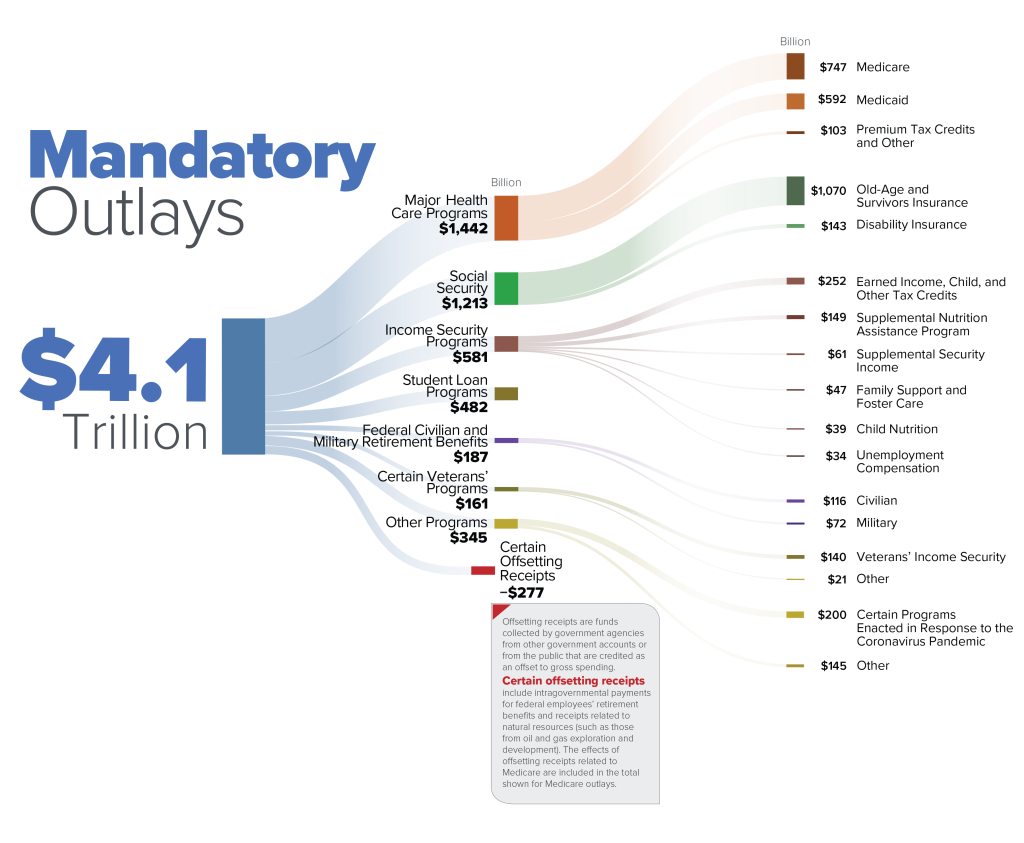
Medicare is the federal government’s health insurance program for the elderly. The program does not employ physicians or other healthcare providers. It is, in effect, a health insurance company funded by the federal government. Established in 1965, Medicare has three main components. “Part A” pays for hospital stays, surgery, and other medical procedures that require admission to a hospital. “Part B” covers supplementary medical services like physician visits and procedures that do not require hospital admission. “Part D” pays for prescription drugs. Part A is funded through payroll taxes and through premiums paid by individual beneficiaries, and Parts B and D are funded mostly through payroll taxes. Since 1966, Medicare enrollment has increased from 19 million to almost 60 million individuals.
Created in 1935, Social Security is a federal income assistance program for retirees. In 2022, 66 million Americans – including 51 million retired workers, 9 million disabled workers, and 6 million survivors of deceased workers – received $1.07 trillion in benefits. Average benefits per month were $1,755 for retired workers, $1,486 for disabled workers, and $1,451 for survivors – all of which are nominally above the poverty rate.
Medicare and Social Security are intergenerational transfer systems. Today’s workers help pay for current retirees’ and beneficiaries’ benefits, not their own future benefits. Put differently, there is no account set aside with your name or contributions on it.
Without legislative action, the Social Security trust funds are projected to be exhausted in 2034. At that point, the Social Security Administration (SSA) will no longer be able to pay beneficiaries’ benefits in full, as the SSA would be limited to the amounts payable from dedicated funding sources, per current law.
Income security programs are cash and cash-like assistance programs outside of Social Security. Most of these programs help individuals pay for specific, basic necessities. Included in income security programs are the Earned Income Tax Credit, supplemental nutrition assistance program (or SNAP), supplemental security income, COVID-19 federal stimulus checks, and unemployment compensation, to name a few. Expanded benefits during and following the COVID-19 pandemic exceeded 10 percent of GDP in 2020 and 2021.
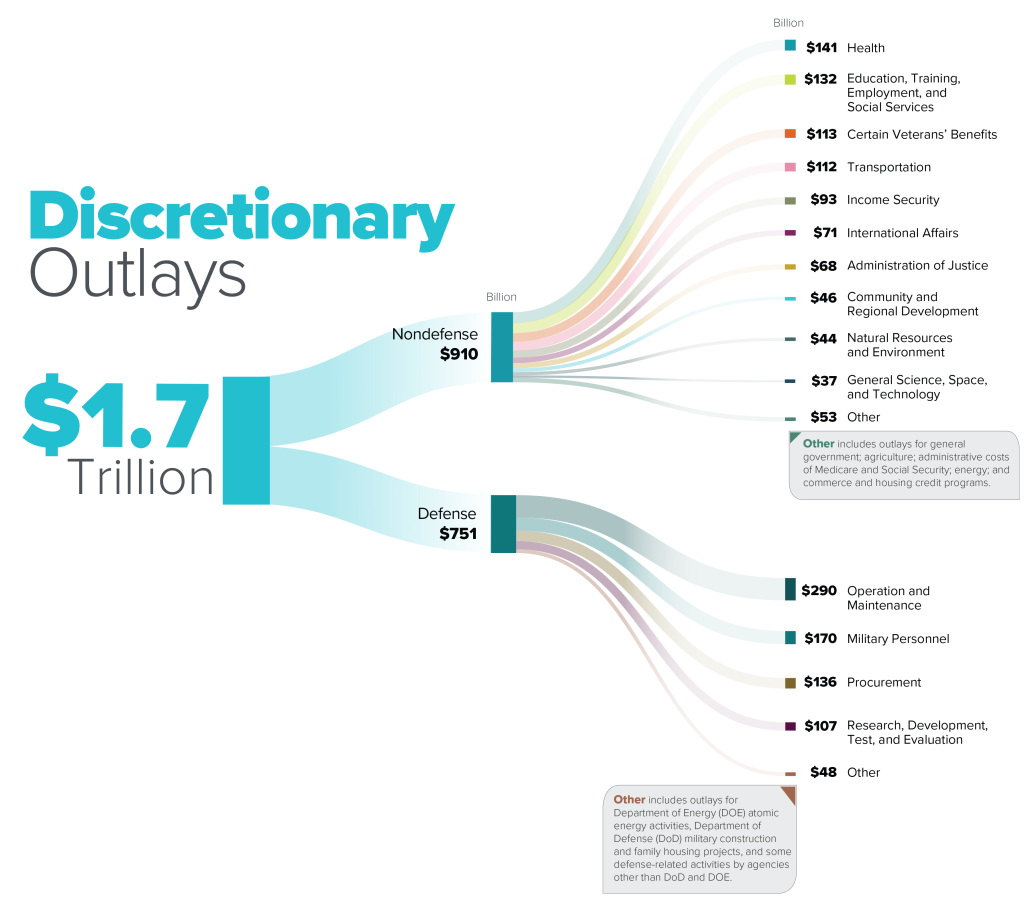
Discretionary spending was $1.7 trillion in FY 2022, including $751 billion in defense spending and $910 in non-defense spending.
National defense includes pay and benefits for all members of the U.S. Army, Navy (including Marines), Air Force, and civilian support services. Defense budgets include capital outlays – spending on items with long useful lives – for military bases, planes, tanks, and other military hardware. National defense spending remains a top priority of the federal government. In FY 2022, defense spending was 13 percent of all federal spending (keep in mind that the $751 billion in discretionary defense spending excludes $113 billion in veterans benefit services that are budgeted as non-defense discretionary spending and $348 billion in veterans’ health and retirement benefits budgeted as mandatory spending).
The U.S. defense budget exceeds those of China, Russia, Saudi Arabia, India, France, the U.K., and Japan – combined! There is considerable debate on whether national defense is, in fact, discretionary spending. That said, the real question is whether, in the absence of any other military superpower, we might be spending more than would be appropriate.
All other spending or non-defense discretionary (NDD) includes appropriations for healthcare and research (including funding for public health and population health agencies like the National Institutes of Health (NIH) and the Centers for Disease Control (CDC), and for health-focused regulatory agencies like the Food and Drug Administration (FDA)), transportation and economic development, education, income security (e.g., special supplemental nutrition program for Women, Infants, and Children (WIC), the low-income home energy assistance program, and child care and development block grants), law enforcement, the environment, and international affairs.
NDD spending was 3.6 percent of GDP. Except in periods of crisis (e.g., the Great Recession and the COVID-19 pandemic), NDD spending has been declining as a share of the economy. Congress, for example, has approved more than $5.3 trillion in federal stimulus spending since the start of the COVID-19 pandemic.
This discussion raises another absolutely essential point: The federal government has a substantial structural deficit. A structural deficit is when a government’s long-term spending exceeds its revenues. In 2022, the federal government had a $1.4 trillion budget deficit (or 5.5 percent of GDP). To support economic recovery, the federal government approved several pieces of legislation that resulted in a $3.1 trillion (or 14.9 percent of GDP) deficit in 2021 and a $2.8 trillion (or 12.4 percent of GDP) in 2020. Assuming no significant changes in spending or revenue policies, the annual budget deficit is projected to grow to 10 percent of GDP.
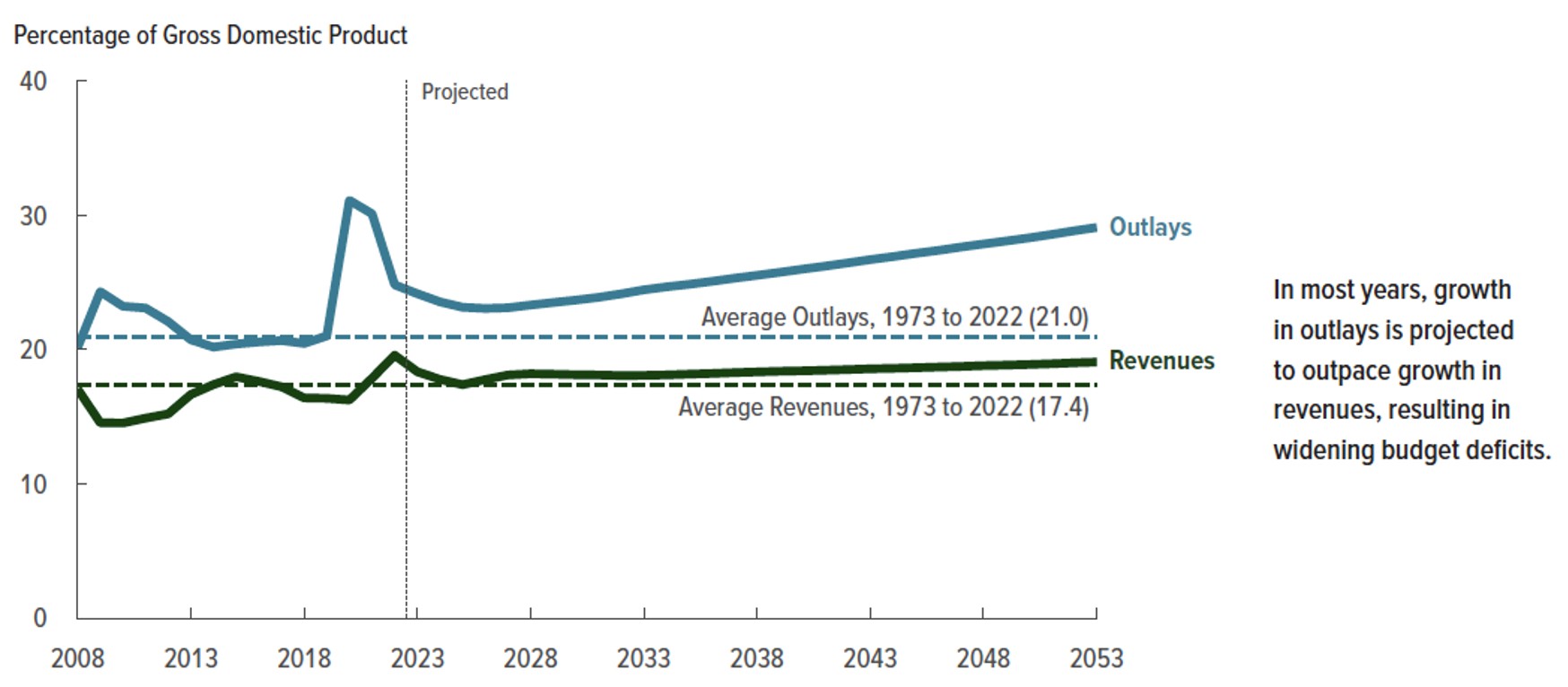
Why is the deficit expected to grow so quickly? In part because mandatory spending is going to continue to grow. More and more of the “Baby Boomer” population will become eligible for Medicare, Social Security, and other programs. As the eligible population grows, so too will spending. The cost of health care services has increased three to four times faster than all other costs across the economy. That’s why health-related non-discretionary spending is the proverbial “double whammy” – the number of people who need those services will increase, and so will the rate of spending per person to deliver those services. At the same time, most economists are projecting slower economic growth for the next several decades. Given the federal government’s current revenue policies, that will mean slower revenue growth over time. Those two main factors – growth in non-discretionary spending and slower revenue growth – will lead to much larger deficits over time.
The federal government’s structural deficit is the single most important trend in public budgeting and finance today. Without major changes in federal government policy, especially in areas like Medicare and Social Security, the federal government will have no choice but to run enormous deficits and cut non-discretionary spending. Those cuts will mean less money for many of the key programs you probably care about basic scientific research, student loans, highways, transit systems, national parks, and every other discretionary program. In fact, some cynics have said that in the future, “the federal government will be an army with a health care system.”
State and local governments will be forced to take on many of the services the federal government used to provide in areas like affordable housing, environmental protection, and international trade promotion. At the same time, some optimists say this is a welcome change. Without the rigidity and uniformity of the federal government, local communities will have the latitude and flexibility to experiment with new approaches to social problems. What’s not debatable is that absent major changes in policy, especially for non-discretionary spending, federal government spending will look quite different in the not-too-distant future.
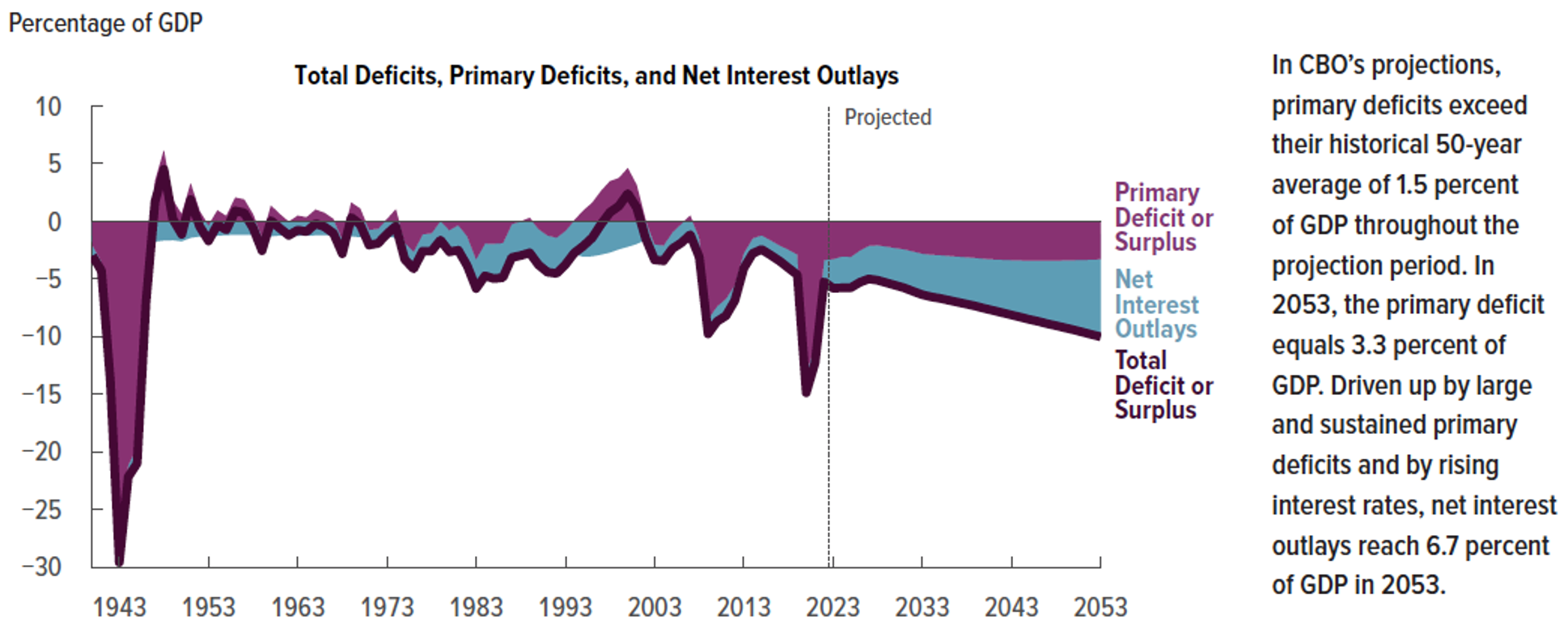
You’re probably wondering how the federal government will finance those deficits. If the government does not collect enough revenue to cover its spending needs, it borrows. The figure below shows national debt as a percent of GDP from 1943, including projections for the three decades. At the end of FY 2019, federal government debt was around 79 percent of GDP and increased to 97 percent of GDP at the end of 2022. The national debt burden is expected to rise to 115 percent of GDP in 2033 and 181 percent in 2053.
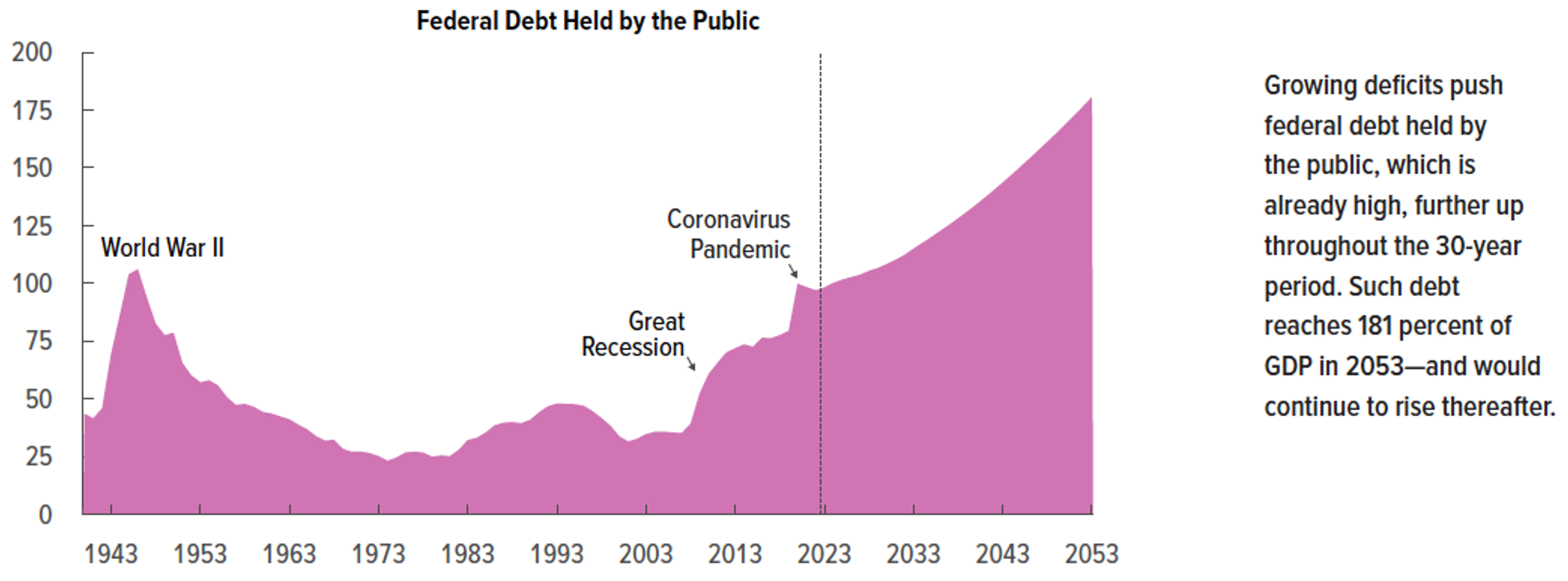
WHAT MOVES INTEREST RATES?
Interest rates are one of the most important numbers in public budgeting and finance. Interest is what it costs to use someone else’s money. Banks and other financial institutions lend consumers and governments money at “market interest rates” like the annual percentage rate (APR). Small changes in interest rates can mean big differences in the cost of delivering public projects. That’s why it behooves public managers to know what drives interest rates.
Interest rates fluctuate for a variety of macroeconomic reasons. If inflation is on the rise, then businesses will be less willing to spend money on new buildings, equipment, and other capital investments. If the demand for capital investments is down, then so is the demand for borrowed money to finance those investments. In those market conditions, banks and other financial institutions will lower their interest rates on loans to entice businesses to make those investments. The opposite is also true. Businesses will seek to invest during periods of low inflation, which drives up demand for borrowed money and drives interest rates up. Government borrowing and capital investment can also drive demand for borrowed money. Macroeconomists have complex models that explain and predict these interrelationships between consumer spending, investments, and government spending.
The U.S. Federal Reserve Bank – “The Fed” – is also a crucial and closely-watched player. The Fed is the Central Bank. It lends money to banks and holds deposits from banks throughout the U.S. Its mission is to fight inflation and keep unemployment to a minimum. In finance circles, this is called the Dual Mandate.
The Fed has many tools to achieve that mission, and most of those tools involve interest rates. It can raise or lower the Federal Funds Rate or the interest rates at which banks lend money to each other. It can demand that banks keep more money on deposit at the Fed. Increases in either will reduce the amount of money banks have available to lend, which drives up interest rates. Its most powerful tool is called open market operations (OMO). If the Fed wishes to lower interest rates, it buys short-term Treasury bonds and other financial securities from investors. This increases the money available for lending and reduces interest rates. When it wishes to raise rates, it sells securities to banks. When banks buy those securities, they have less money available to lend, and that increases interest rates.
This rapid growth in debt is concerning for many reasons. First, federal government borrowing “crowds out” borrowing by small businesses, homeowners, state and local governments, and others who need to borrow to invest in their own projects. Since there are only so many investors with money to invest, if the federal government takes a larger share of that money, there’s less for everyone else. Many economists and finance experts have also warned that if the federal government’s debt grows too high, then investors might be less willing to loan it money in the future. If investors are less willing to loan the government money, the government must offer higher interest rates to increase investors’ return on investment. As the federal government’s interest rates rise, interest rates rise for everyone else. Occasional increases in interest rates are not necessarily bad, but prolonged high-interest rates mean less investment by people and businesses, resulting in lower productivity and slower economic growth.
WHAT IS THE DEBT LIMIT?
Created by Congress in 1917, the debt limit, or debt ceiling, sets the maximum amount of debt the U.S. government can incur.[3] The amount is set by law, and once the limit is reached, the government must either (a) raise the debt limit, (b) suspend the debt limit from taking effect, (c) violate the debt limit or (d) default on its obligations to pay its bills. Congress has raised or suspended the debt limit more than 100 times since 1940. Raising or suspending the debt limit does not authorize new spending. It simply allows for the government to pay for obligations that Congresses and presidents have made in the past.
With political polarization deepening over the last decade, votes to raise the debt ceiling have remained contentious, with congressional budget hawks increasingly demanding spending cuts in return for their support. On January 19, 2023, the U.S. Treasury reported it had reached the $31.4 trillion debt limit and begun using “extraordinary measures” to meet the government obligations without violating the limit. Following negotiations, Congress voted to suspend the nation’s debt ceiling through January 2025 in exchange for limits on the growth in non-defense spending. Suspending the debt ceiling gives Treasury the latitude to borrow as much money as it needs to pay the nation’s bills. It also kicks the potential fight for raising the debt ceiling past the next presidential elections.
Treasury Securities Outstanding (July 2023, $Billions)[4]
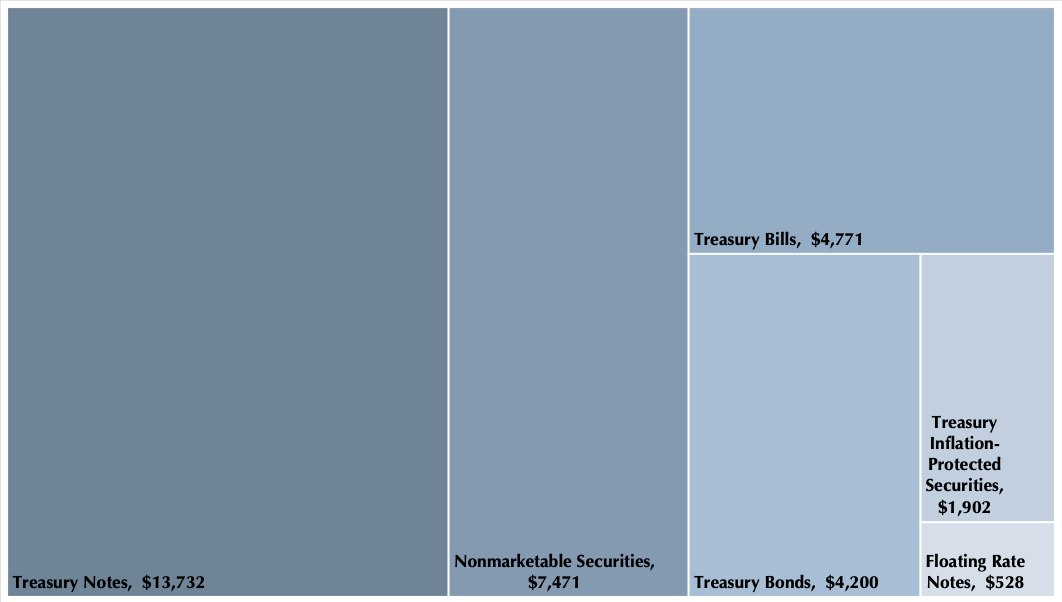
Debate on the debt ceiling is not a costless effort. With every debt ceiling debacle, confidence in the U.S. government, the world’s reserve currency, is eroded. The last time the U.S. was pushed to the brink of a default resulted in a rating downgrade by S&P, one of the major rating agencies (from AAA to AA+). On August 1, 2023, Fitch Ratings downgraded the U.S. long-term rating to AA+ from AAA, citing “growing general government debt burden and the steady deterioration in the standards of governance.” Uncertainty will likely raise interest rates. Higher interest rates make solving the long-term fiscal problem harder, with ramifications for practically every sector of the economy. While the economic consequences of an intentional default, an unprecedented event in American history, are unknown, there is no doubt they would be catastrophic.
STATE GOVERNMENTS
There’s an old adage that state governments are in charge of “medication, education, and incarceration.” That saying is both pithy and true. State government expenditures in 2021 were $2.3 trillion, and most of it was spent on primary and secondary education, public universities and community colleges, healthcare, public assistance, state highways, corrections, and public safety.
States vary a lot in how much of those services they deliver and how they pay for those services. In some regions, the state is one of the largest employers. This is especially true in rural areas with state universities or prisons. In other regions, state governments have a limited presence.
States rely on a few key revenue sources. State-wide sales taxes are one-fifth of state government revenue and nearly 50 percent of state tax revenues. There are two basic types of sales taxes: a general sales tax that applies to all retail sales transactions and special sales taxes that apply only to sales of certain goods and services, such as gasoline, tobacco, alcohol, and gambling. Some states tax construction, personal trainers, catering, and other professional services, while many do not. Many special sales taxes are administered as excise taxes.
Five states (Alaska, Delaware, Montana, New Hampshire, and Oregon) do not have state-wide sales tax. Although, Alaska does allow its local governments to collect local sales taxes. California has the highest state-level retail sales tax rate, at 7.25 percent, followed by Indiana, Mississippi, Rhode Island, and Tennessee at 7 percent (Tax Foundation, State and Local Tax Rates 2023). States that are heavily reliant on sales and excise taxes are more likely to have regressive tax systems.
Like with the income tax, sales tax revenues are derived from a tax rate applied to a taxable base. A state’s sales tax base is all the retail sales of personal property that happen within its borders. The challenge is that it’s not always clear what is included in that taxable base. For instance, in Illinois, candy that contains flour and does not require refrigeration (e.g., Twix) is exempt from the state’s retail sales tax. In New York, an “unaltered bagel” is not subject to the 8.85 percent retail sales tax, whereas a sliced bagel is. When a company does business in multiple states, it must follow complex tax codes to determine the sales tax it owes in each state.
Online retailers like eBay and Amazon have long argued that they should not have to collect and remit sales taxes if they do not have nexus (or physical presence) in the state in which the purchaser resides. In 2018, the U.S. Supreme Court ruled in South Dakota v. Wayfair that businesses with more than 200 transactions or $100,000 in-state sales – but without a physical presence in the state – must collect and remit sales taxes. Consumers are now required to remit sales taxes to the vendor or pay an equivalent amount known as a use tax directly to the state. Some states will go so far as to send residents an estimated use tax bill to residents if the vendor fails to collect and remit sales taxes.
In many states, the goods and services purchased by businesses for the purposes of producing a good or delivering a service are exempt from sales taxes. Doing so prevents tax-pyramiding. For these and other reasons, sales tax administration is quite complex.
State and Local Government Revenues by Source (2021)
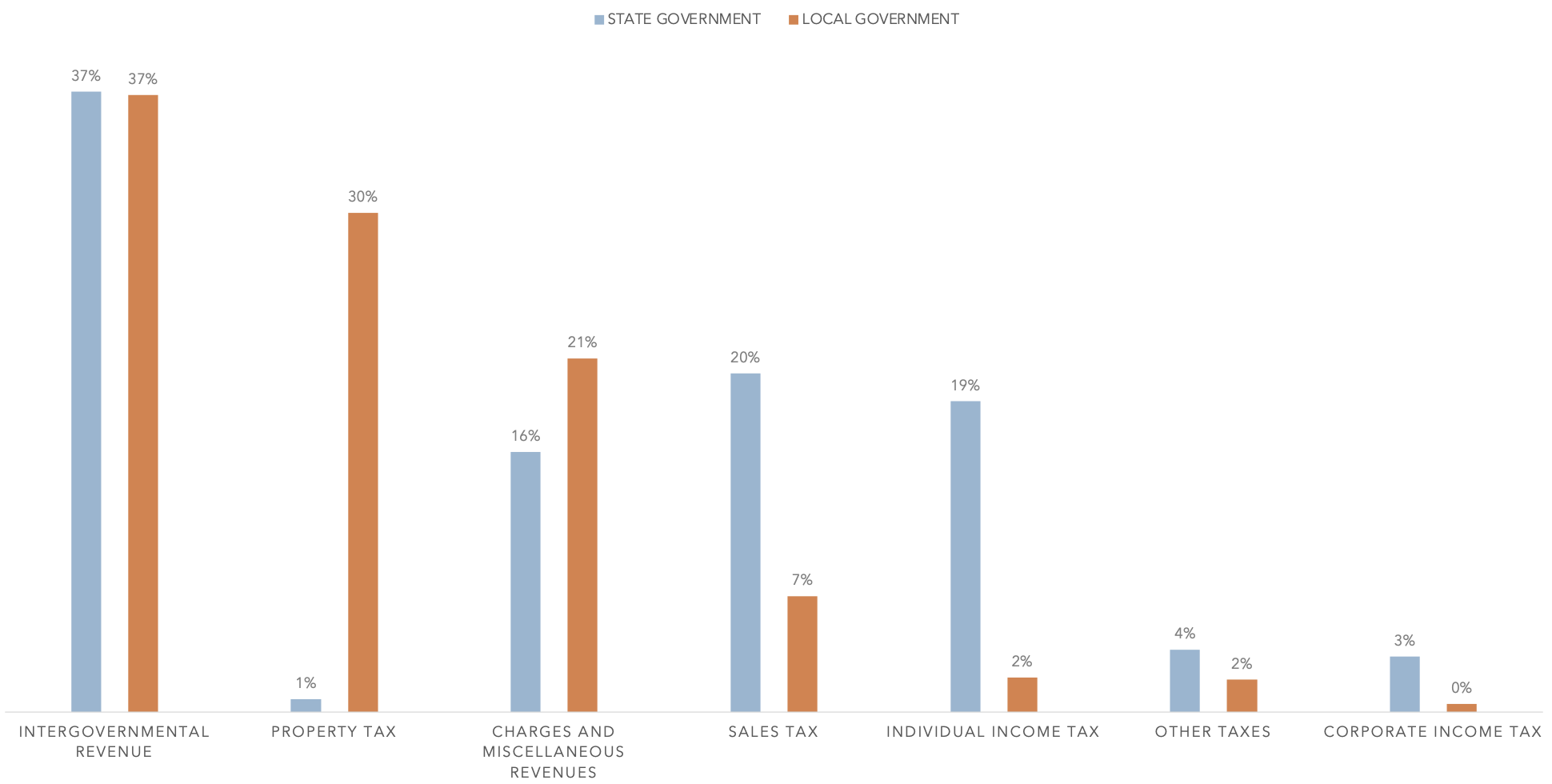
State-wide individual income taxes are one-fifths of state government revenue and one-third of state tax revenues. Seven states – Alaska, Florida, Nevada, South Dakota, Texas, Washington, and Wyoming – do not have a state-wide individual income tax.
State income taxes are administered much like the federal income tax. In fact, most states apply the federal government’s definition of taxable income to determine state taxable income. In New Hampshire and Tennessee, the individual income tax is limited to dividend and interest income only (Tax Foundation, State Individual Income Tax Rates, and Brackets 2020).
Thirty-two states have graduated-rate income taxes. A graduated-rate structure does not guarantee progressivity. Higher rates have to apply to high-income taxpayers while holding harmless low- and middle-income taxpayers. Tax credits (e.g., childcare credit, earned income tax credit), exemptions, and deductions specifically targeted toward low- and middle-income taxpayers can enhance the progressivity of an income tax.
State Government Tax Revenues (by Source, 2022)
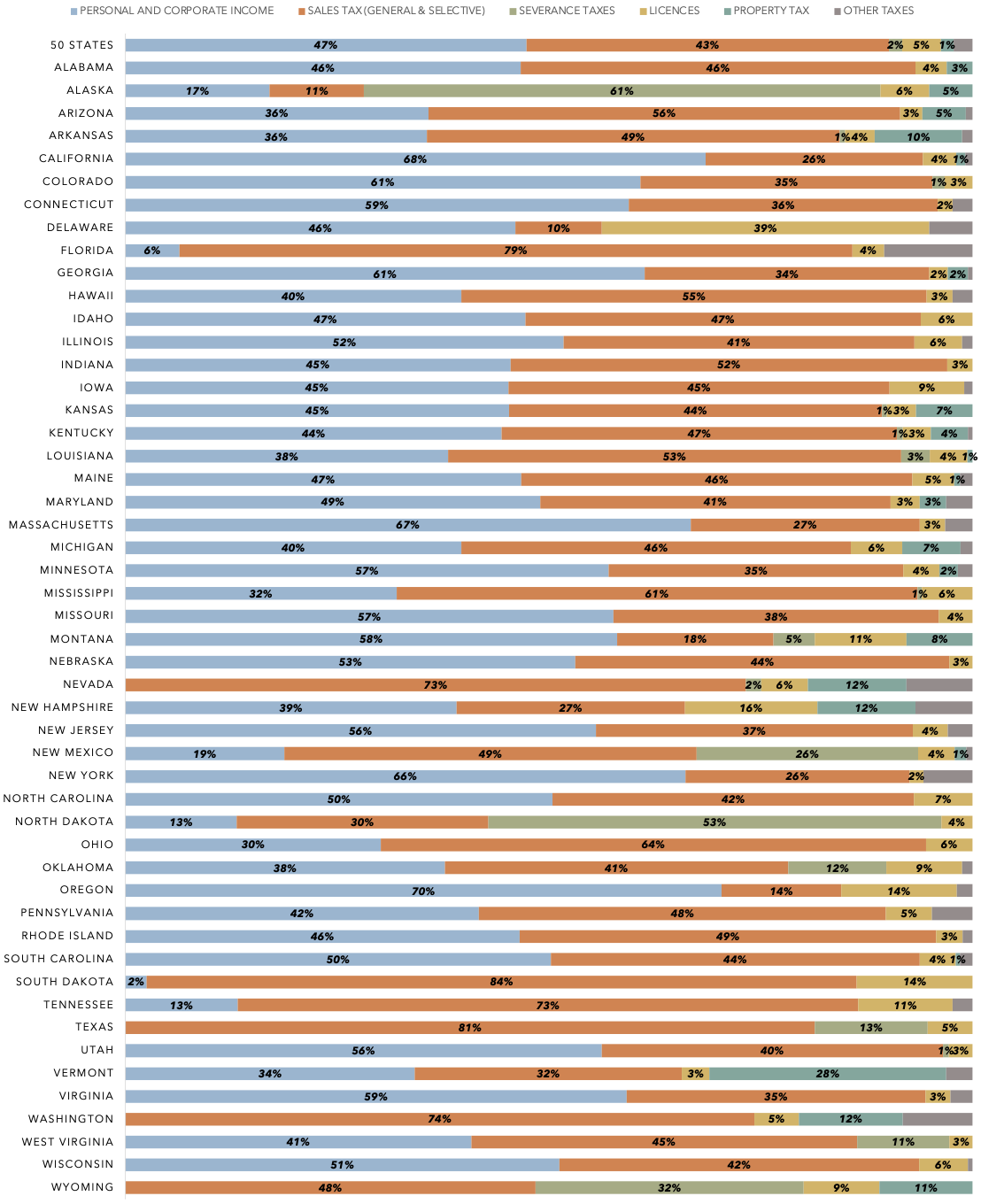
WHAT IS A “FAIR” TAX?
Governments tax many different types of activity with many different types of revenue instruments (taxes, fees, charges, etc.). Each instrument is fair in some ways but less fair in others. In public finance, we evaluate taxes across several dimensions:
-
Efficiency. Basic economics tells us that if a good or service is taxed, then consumers will purchase or produce less of it. An efficient tax minimizes these market distortions. For instance, most tax experts agree that the corporate income tax is one of the least efficient. Most large corporations are willing and able to move to the state or country where they face the lowest possible corporate income tax burden. When they move, they take jobs, capital investments, and tax revenue with them. The property tax, by contrast, is one of the most efficient taxes. The quantity of land available for purchase is fixed, so taxing it cannot distort supply the same way that taxing income might discourage work, or that taxing investment might encourage near-term consumption.
-
Vertical Equity. Vertical equity means the amount of tax someone pays increases with their ability to pay. Most income tax systems impose higher tax rates on individuals and businesses with higher incomes. This is meant to ensure that taxpayers who have a greater ability to pay will contribute a higher share of their income through taxes.
A tax with a high degree of vertical equity, like the income tax, is known as a progressive tax. A regressive tax is a tax where those who have less ability to pay ultimately pay a higher share of their income in taxes. The retail sales tax is a regressive tax. Those who are least able to pay often pay comparatively more of it as a share of income. For instance, a family with high annual income will pay the same amount in sales tax for school supplies as a low-income family. The effective tax rate (i.e., sales tax liability as a percent of income) will be higher for the low-income household when compared to the high-income household.
-
Horizontal Equity. Sometimes called “tax neutrality,” horizontal equity means that people with similar abilities to pay contribute a similar amount of taxes. The property tax is a good example of a tax that promotes horizontal equity. With a properly administered property tax system, homeowners or business owners with similar properties will pay similar amounts of property taxes. Income taxes are quite different. Because of tax preferences, it’s entirely possible for two people with the same income to pay very different amounts of income tax.
-
Elasticity. An elastic tax responds quickly to changes in the broader economy. If the economy is growing and consumers are spending money, collections of elastic taxes increase and overall revenue grows. This is quite attractive to policymakers: with elastic taxes, they can see growth in tax collections without increasing the tax rate. Of course, the opposite is also true. If the economy is in recession, consumer spending decreases, and so do revenue collections. Sales taxes and income taxes are the most elastic revenues.
-
Stability. A stable tax does not respond quickly to changes in the economy. Property taxes are among the most inelastic taxes. Property values do not fluctuate as much as prices of other goods, so property tax collections don’t increase or decrease nearly as fast as sales or income taxes. While the tax is stable, it does not grow as fast. Put differently, the property tax is stable but inelastic, whereas the income tax is elastic but unstable.
-
Administrative Costs. Some taxes require a lot of time and resources to administer. Property taxes are a good example. Tax assessors go to great lengths to make certain the appraised value they assign to a home or business is as close as possible to its actual market value. To do this, they perform spatial analysis. That analysis demands time and expertise.
The chart below illustrates a basic fact about taxation: all taxes come with trade-offs. For instance, the property tax is stable and promotes horizontal equity, but it’s costly to administer and generally non-responsive to broader trends in the economy. The sales tax is cheap to administer and produces more revenue during good economic times but is regressive. To ensure vertical equity, the income tax has to impose higher taxes on individuals and businesses with higher incomes. Note that for many of these instruments, the evidence is mixed. That is, tax policy experts disagree on whether that characteristic is a strength or weakness for that particular revenue instrument.
Property Tax |
Sales Tax |
Income Tax |
Charges & Fees |
||
Vertical Equity |
+/- |
– |
+ |
– |
|
Elasticity |
– |
+ |
+ |
+/- |
|
Stability |
+ |
– |
– |
+/- |
|
Administrative Cots |
– |
+ |
+/- |
+/- |
|
Horizontal Equity |
+ |
+ |
– |
+ |
|
Efficiency |
+ |
+/- |
– |
+/- |
|
Strength |
+ |
Weakness |
– |
Mixed |
+/- |
In their 2018 “Who Pays” report, the Institute of Taxation and Economic Policy (ITEP) once again found that states that rely on sales and excise tax and less on graduated personal income taxes are more likely to tax their lowest-income residents at higher rates than the top one percent of taxpayers.
ITEP’s Tax Inequality Index measures the effects of each state’s tax system on income inequality by assessing its impact on the incomes of taxpayers at different income levels. The chart below shows that states without a personal income tax (Washington, Texas, Florida, South Dakota, Nevada, and Tennessee) and those with a flat personal income tax (e.g., Pennsylvania and Illinois) have regressive tax structures. States with graduated personal income taxes that hold harmless low- and middle-income taxpayers are less regressive or, in more positive terms – progressive. The distributional impact of the tax systems on income has clear implications for wealth inequality among racial groups. Tax codes that are regressive not only worsen income inequality; they also worsen the racial income and wealth divides.
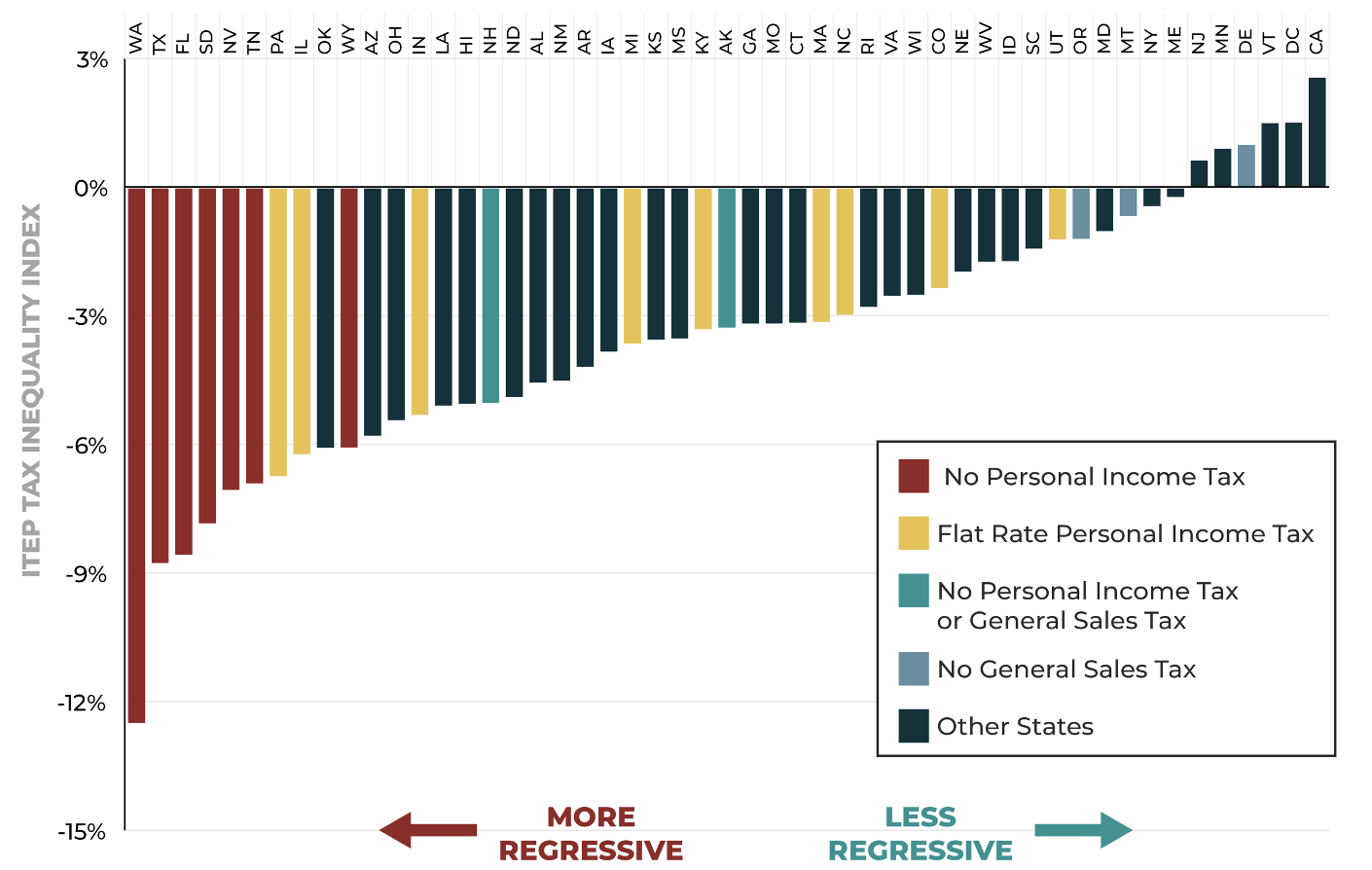
All state governments depend to some extent on intergovernmental revenues (IGRs). For state governments, IGRs are used to meet the federal government’s share of mandatory spending. Medicaid is the largest and most important for most states. The federal government also sends states money for transportation infrastructure, the Child Health Insurance Program (or S-CHIP), federal student loan assistance, and many other programs.
Federal IGR falls into roughly two categories: categorical grants that are restricted to specific purposes and block grants that are less restricted but must produce measurable outcomes or deliverables. Federal funds for highways and university research are good examples of categorical grants. The Community Development Block Grant program is a good example of a block grant.
Most state revenues are from the sales tax, income tax, and IGR. That said, states do depend on a variety of other tax revenues (e.g., taxes on oil, gas, coal, other minerals, timber, and fish, as well as death and gift taxes). Some states levy a property tax on transactions of certain personal property, like vehicles. States also generate revenue through fees, including tuition from public universities and colleges, highway tolls, charges to patients and private insurance companies at public hospitals, and licenses on everything from hunting to running a tavern to practicing medicine. Some states also tax private electricity and water utility operators.
State spending has grown substantially over the past few decades. In 1977, the average state’s per capita spending was around $2,800. In 2021, it was $7,500. Revenues have grown on a similar trajectory. But note that growth was not uniform. Spending in states like Arizona, California, Colorado, and Washington grew far slower than the average. This is not a coincidence. These states have passed strict laws, broadly known as tax and expenditure limitations, that restrict how quickly their revenues and spending can grow. States without those limits, like Connecticut, Delaware, New York, and Massachusetts, have seen much faster growth in both revenues and spending. North Dakota, Wyoming, and New Mexico saw large jumps in revenues and spending in the past decade or so, due mostly to the growth of their respective shale oil industries (more commonly known as fracking).
A third important trend is that state revenues roughly equal state spending. Virtually every state’s constitution requires that its legislature and governor pass a balanced budget. As you’ll see later, a “balanced budget” can mean rather different things in different places. But overall, states do not spend more money than they collect. This is in sharp contrast to the federal government. As you saw above, throughout the past several decades the federal government’s spending has routinely exceeded its revenues. Unlike the federal government, states cannot borrow money to finance an operating budget deficit. In a number of states, restrictions on balanced budgets are enshrined in law.
Most of state spending is around health, education, transportation, and corrections. About one-half of state spending was in social services – which includes state spending on the Medicaid and mean-tested cash assistance programs ($795 billion); state investment in public hospitals and community clinics; and healthcare programs like vaccinations, diabetes prevention, and outreach programs to prevent sexually transmitted diseases ($177 billion).
Medicaid is the federal government’s healthcare program for the poor. It is delivered in partnership with the states. Each state designs its own Medicaid program, and the federal government covers 50-70 percent of the spending related to that program.
Medicaid is non-discretionary spending for state governments. Medicaid is to the states what Medicare is to the federal government: a massive health insurance program that is expected to cover more people and become vastly more expensive over time. In most states, an individual qualifies for Medicaid once their income falls below a certain level. Medicaid is also the default health insurer for many vulnerable populations, including foster children, the permanently disabled, and the mentally ill. Older individuals who are poor or disabled often qualify for both Medicare and Medicaid. They are known as dual-eligibles – 18 percent of Medicare patients are eligible for Medicaid coverage as well. In fact, growth in Medicaid spending is the result of spending on long-term care and nursing homes for the elderly.
State and Local Government Spending (by Function, 2021)
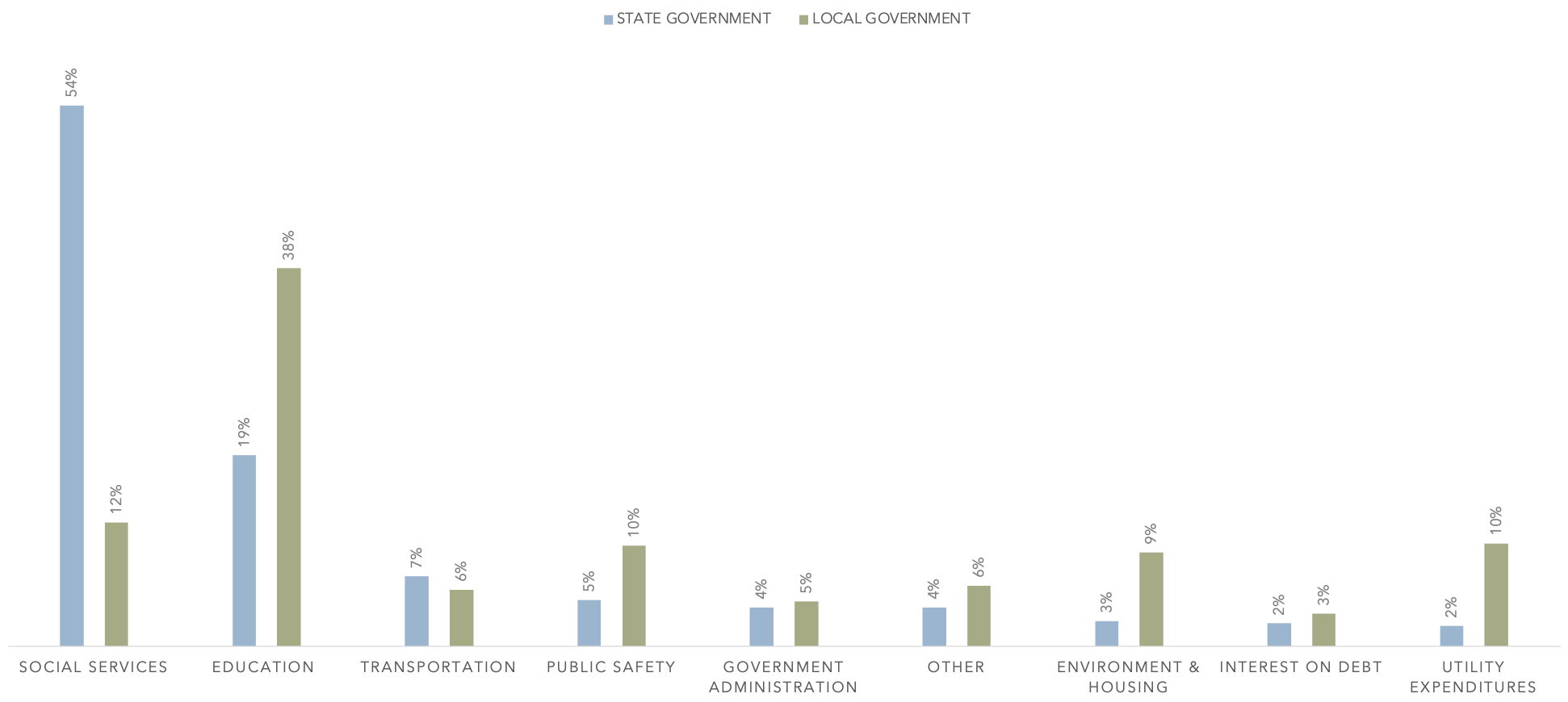
MEDICAID EXPANSION
As part of the Affordable Care Act (ACA), the federal government offered states a once-in-a-generation opportunity: If states expanded their Medicaid programs to cover more uninsured people, the federal government would cover up to 90 percent of the costs for that expansion. As of August 2023, 41 states have implemented the ACA. Analysis shows that expansion states experience a substantial increase in Medicaid spending. That spending was subsidized with federal funds. In other words, the ACA did not crowd out state spending in other priority areas like education, transportation, or public assistance. More importantly, the 35 states that expanded healthcare coverage before the COVID-19 pandemic reported lower uninsured rates and were better positioned to respond to the public health emergency by providing coverage to millions of Americans who lost their job-based healthcare coverage.
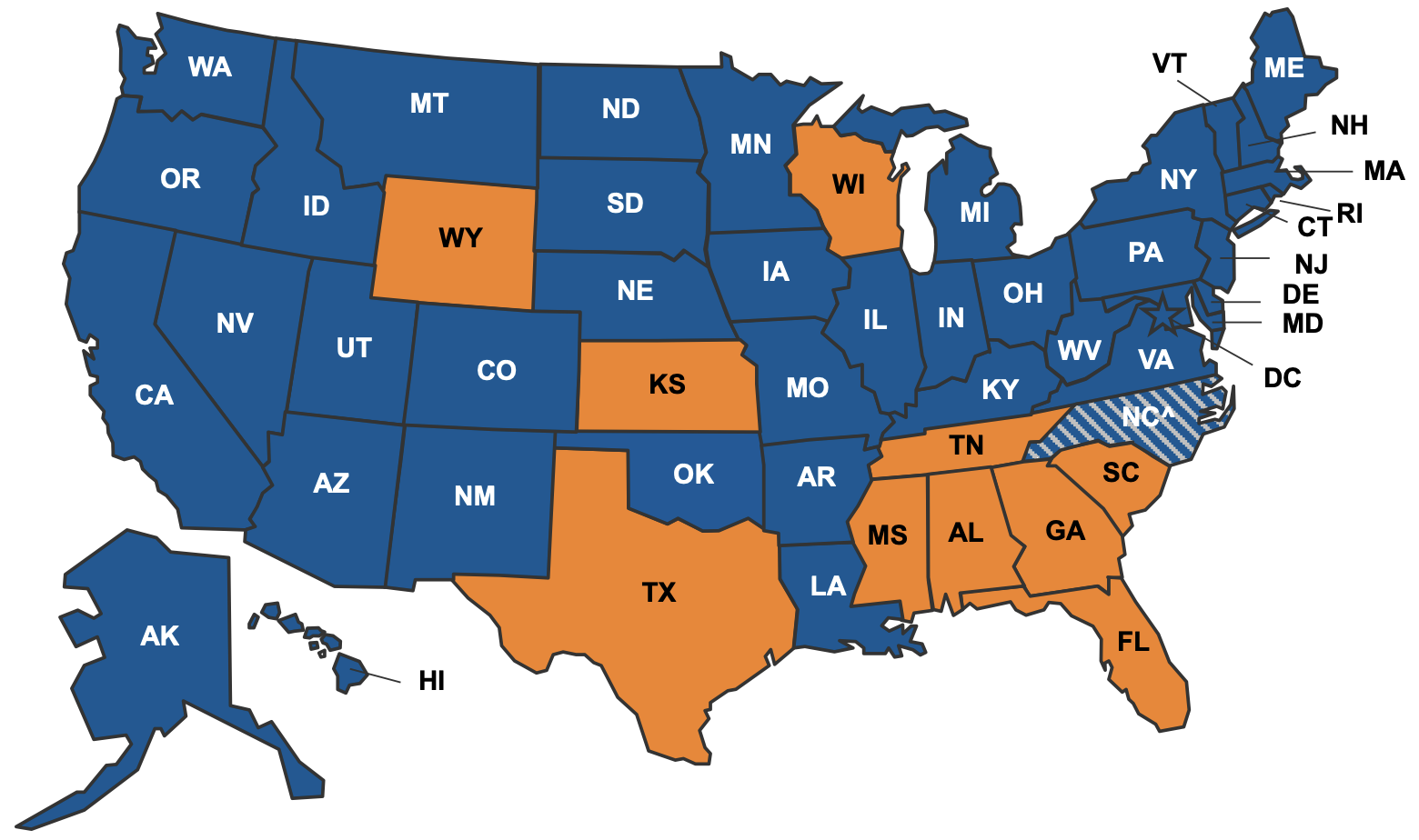
KEY
Blue = Medicaid Expansion adopted and implemented. Orange = Medicaid Expansion not adopted. Blue Stripes = Medicaid Expansion adopted, but not implemented.
Around 19 percent of state spending was on public education, including public universities, colleges, and public libraries.
Virtually every state constitution has language that calls out funding primary (Kindergarten through eighth grade) and secondary (ninth through 12th grade) public education as the state’s principal responsibility. In most states, public education is delivered by local school districts but paid for in large part with local government property tax revenues and state funds distributed to school districts using formulas that factor in the number of students, student demographics, and local property wealth – all to ensure adequate and equitable funding.
State governments’ direct expenditures in elementary and secondary education are nominal ($6 billion). Direct spending is executed by local governments – often by school districts, but sometimes municipal governments or townships ($750 billion, or 38 percent of local government spending).
State governments directly support public universities and colleges ($264 billion); the remainder is invested by local governments in their community colleges and public libraries ($76 billion).
State and local government investment in transportation – including highways, airports, sea and inland ports, and parking facilities – were eight percent of state government spending, with significant variation across states. Large states like Alaska and Texas dedicate up to 20 percent of their annual spending to building and maintaining highways, airports, and seaports. By contrast, New England’s state highway systems are far smaller, so state spending on transportation is not nearly as large a share of overall state spending.
State and local governments finance most of their investments in infrastructure by borrowing money – usually through municipal bonds – that they repay over time. Interest on that debt was three percent of state government spending.
Public safety was 5 percent of state government spending. For state governments, corrections (i.e., prisons, detention centers, parole officers, and state crime prevention programs) are a significant proportion of spending. Unlike local governments, state spending on police is a small share of total spending with much of that spending related to state patrols and criminal investigations.
Spending on parks, environment conservation programs, clean water initiatives, housing redevelopment, and economic development was three percent of state government spending.
Government administration – including state spending on courts, legal services, legal counseling of indigent or other needy persons, legislative bodies, and agencies concerned with tax assessment and collection, budgeting, accounting, and financial reporting was four percent of government spending.
Finally, pensions and other post-employment benefits (OPEB) for retired state government workers are one of the most important and fastest-growing components of other expenditures (three percent).
The discretionary vs. non-discretionary spending distinction is critically important to the states. Medicaid and primary/secondary education are effectively non-discretionary programs. State legislators can change their state Medicaid laws and policies, and many have. But without a policy change, Medicaid spending is formula-driven and locked in. Primary and secondary education spending is also driven by formulas that require the state to send a given amount of money to local school districts each year, barring some substantial policy change. States must also pay the interest on their debts and make good on their pension and other post-employment benefit (OPEB) promises. Taken together, non-discretionary spending for state governments is around 70 percent of total spending. That’s why when revenues fall short of expectations and states need to balance their budgets, they have little choice but to scale back on the 30 percent that remains in discretionary areas like higher education, public health programs, transportation, and government administration.
We were reminded of this fact in the Great Recession when state governments cut spending on higher education by an average of 35 percent and public health programs by an average of 50 percent. We expected history to repeat itself at the start of the COVID-19 pandemic; however, the influx of federal stimulus funds coupled and the mild recession – amid the pandemic resulted in a majority of states reporting surpluses, not deficits, FY 2021 and FY 2022.
PUBLIC PENSION PROBLEMS PERSIST!
The chronic underfunding of public sector retirement systems is arguably one of the most significant fiscal challenges facing state and local governments to date. The 50-state pension funding gap – the difference between state retirement systems’ assets and projected benefit payments to employees – was $1.25 trillion at the end of FY 2019 (Pew, 2022).
While the Great Recession exacerbated the public sector retirement crisis, it did not create it. Pension problems were long in the making as states opted to increase employee pension benefits in lieu of annual wage adjustments. At the same time, they failed to make their annually required contributions and instead relied on robust returns on investments and above-average discount rates to value their long-term obligation. These actions resulted in inflated assets and understated liabilities.
While reforms have faced legal setbacks, several states have been able to scale back on their plan benefits, including limiting benefits to current employees, demanding higher contributions, limiting or ending eligibility for new employees, and creating defined contribution plans or hybrid retirement plans. While policy changes represent improvements on the margin, they do not resolve plan insolvency.
Why would pension underfunding present a fiscal challenge to governments? First, pension obligations are akin to general obligation (GO) debt in that general tax dollars will be used to make payments on retiree benefits. However, unlike general government long-term debt obligations, liabilities associated with retirement benefits are less visible to the public, face no constitutional or statutory limitations, and do not require voter approval. What’s more, governments can do little to modify benefits to existing employees, retirees, or their beneficiaries once granted. Unfunded retiree benefits represent a substantial reallocation of future cash flows on what is, in essence, an unpaid historical cost.
Unfunded Pension Liabilities as a Share of State Personal Income (2019)
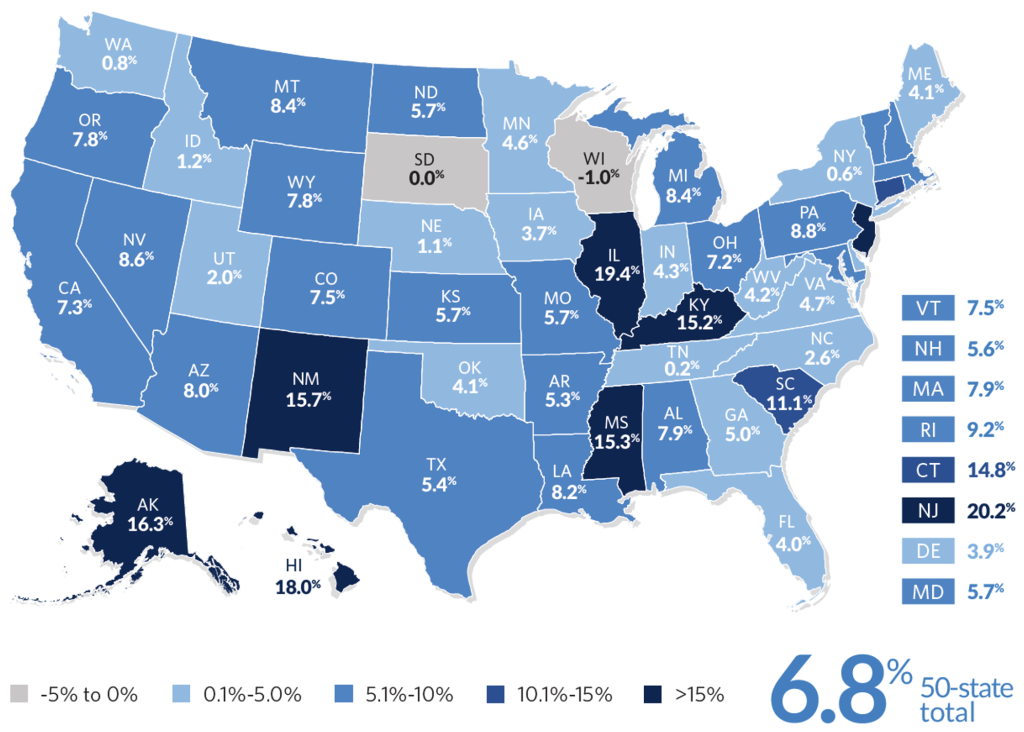
LOCAL GOVERNMENTS
In addition to the federal government and the 50 state governments, the Census Bureau recognizes five basic types of local governments: counties, municipalities (i.e., cities, boroughs, and villages), townships (i.e., towns or townships), special districts, and school districts. Counties, municipalities, and townships are recognized as general-purpose governments, whereas school districts and special districts are recognized as special-purpose and single-purpose governments, respectively.[5]
Municipalities fund and manage public schools, utilities, large cash-transfer assistance programs, and major infrastructure networks. No two municipal governments are alike. Some operate their own electric utilities and water companies. Some operate golf courses, swimming pools, and other recreational facilities. Cities like Austin, Jacksonville, and Seattle have financial structures dominated by large public utilities. Some have programs to fight homelessness and promote affordable housing, both areas that until recently were managed by the state and federal governments. Others have programs to fight climate change, promote tourism, and acclimate new immigrants to their communities. Of all the levels of government, municipalities offer the most variety in their size and scope of services.
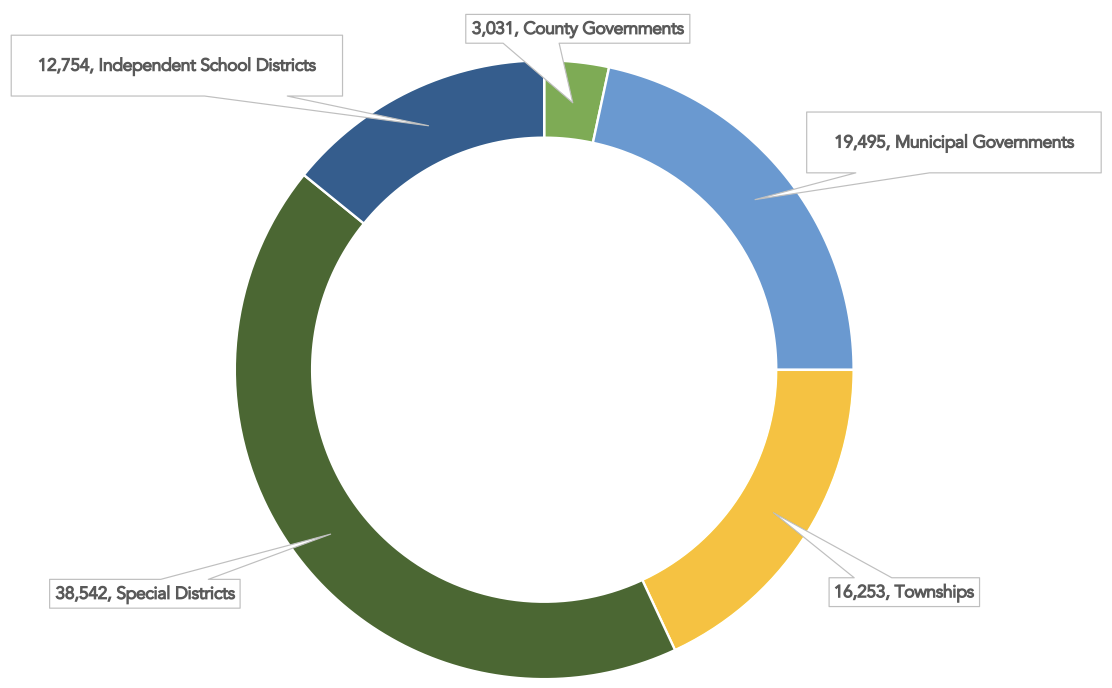
Counties are often called the “bottom of the fiscal food chain.” They deliver expensive and human capital-intensive services like public health, elections, tax administration, and regional transit systems. In some sense, counties are the opposite of municipal governments and townships. Counties manage services where a broader geographic reach, relative to municipalities, is more practical and economical. Elections, for example, are usually a county function. Instead of dozens of municipalities conducting their own elections, county governments manage county-wide elections that cover all the municipal and county officials elected within the county. Tax administration is another example. Property assessors are usually positioned within a county government but execute property assessments for all the municipalities and other taxing jurisdictions within their county. For this same reason, counties are usually responsible for a majority of human service programs, including public health and mental health services.
Local governments depend on the same revenue sources but in different configurations.
Property taxes are the local revenue workhorse. They are the oldest local revenue source and the only tax found in all 50 states. For the past two decades, they have accounted for at least 30 percent of all local government revenues – with significant variation across the states. There are good reasons for this. Property taxes are simple and transparent. They follow the same basic taxable base times tax rate concept you’ve already seen with both the income tax and the sales tax (see below for more details on property tax administration). And yet, property taxes are wildly unpopular. Taxpayers get angry when their tax bill increases, but their income does not. They also struggle to understand how the government determines their property value. That’s why the property tax is often called the “necessary evil” of local revenue systems.
In 38 states, the state government has authorized local governments to levy a local sales tax. In all, around 6,500 municipal governments rely on local sales tax revenues for seven percent of total revenues. Applicable rates and taxable bases vary. The five states with the highest average local sales tax rates are Alabama (5.25 percent), Louisiana (5.10 percent), Colorado (4.88 percent), New York (4.52 percent), and Oklahoma (4.48 percent). Some city and county governments have a general sales tax to fund local services. Other local sales taxes are much smaller rates but have more specific purposes like public education, public safety, public health, or tourism. For example, in 2000, voters in Brown County, WI, authorized a 0.5 percent sales tax to fund improvements to Lambeau Field, home of the Green Bay Packers of the National Football League (NFL).
Local income taxes are common in areas with lots of commuters. In fact, they are often called commuter taxes or head taxes. Central cities often lament commuters who work in the central city and use central city services but do not pay for those services because they own property outside the central city. Local income taxes impose a tax on wages, income, and other earnings in the jurisdiction where that income is earned. This is the logic behind local income taxes in several large cities like Birmingham, Denver, Kansas City, New York City, Philadelphia, St. Louis, and Washington, D.C. Several municipalities in greater Portland impose a local income tax to help fund Tri-Met, the regional light rail system. This is an interesting twist on the commuter tax model. Ohio authorizes all its municipal governments to levy a local income tax. The central criticism of local income taxes is that they drive away business. That is, if a local business can avoid paying the local income tax simply by moving to another jurisdiction, it will have a strong incentive to do so.
Local Government Own Source Revenues (by Source 2021)
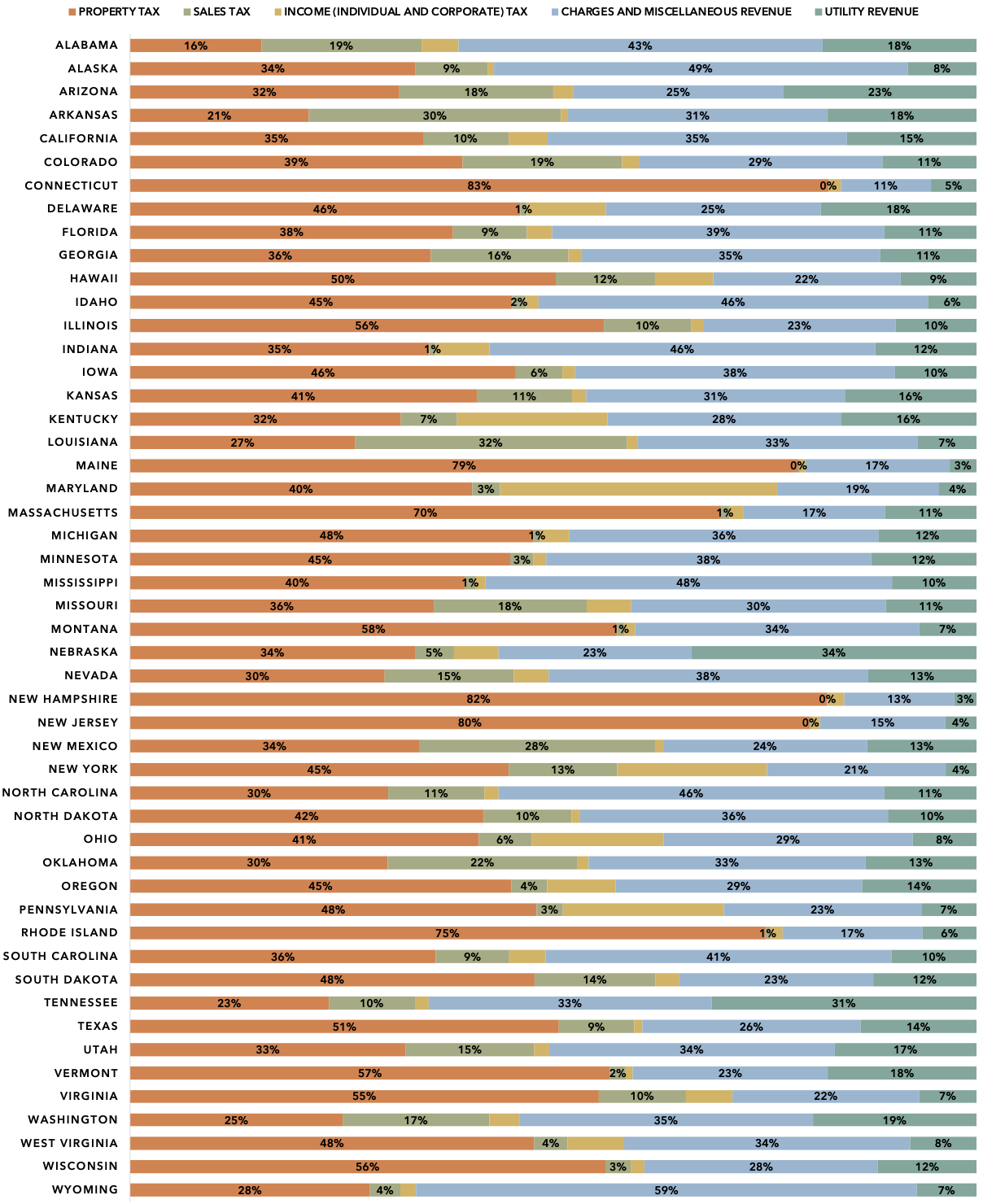
JUMPSTART SEATTLE
Two years after passing and then repealing the head tax (planned to be $275 per employee), the Seattle City Council approved a new payroll tax. Christened “JumpStart Seattle,” the city’s payroll ordinance imposes a tier-rate payroll tax on businesses with annual payrolls of more than $7 million on a sliding scale from 0.7 percent on employee wages between $150,000 and $399,999 up to 2.4 percent, with the highest rates applying to employees reporting income in excess of $400,000 who are employed by businesses with more than $1 billion in annual payroll expenses. However, unlike the OASDI, this payroll tax is a tax on the employer, even though the basis of the tax is employee wages.
Businesses with payroll expenses of less than $7 million, grocery stores, insurance businesses, certain motor vehicle businesses, federal, state, and local government entities, and independent contractors whose compensation is included in the payroll expense of another business that is subject to the tax are exempt from the payroll tax. Additionally, not-for-profit healthcare entities are exempt from the payroll tax on employees with annual compensation of $150,000 up to $400,000 for the period January 1, 2020, through December 31, 2023.
The tax, which was expected to yield $210 million in its first year, brought in more than $230 million. Revenues from the tax were used to mitigate the effects of the COVID-19 public health and economic crisis and finance affordable housing investments and equitable development projects in the future.
Local governments depend on a variety of intergovernmental revenues. Many state governments offer municipalities grants to fund a variety of needs, especially infrastructure. States have revolving loan programs to help city and county governments pay for roads, bridges, drinking water systems, stormwater management systems, and other basic infrastructure.
Federal intergovernmental revenues also assist municipalities with transportation infrastructure, affordable housing, community development, community policing, and many other initiatives. In a few states, municipalities receive up to 40 percent of their revenues through state revenue-sharing programs. This is most common in states where local governments are not authorized to levy a local sales tax or are subject to strict property tax limits.
Municipalities also employ dozens of “other” revenue sources. Some tax utilities, both publicly owned and privately owned, are within their borders. Municipalities also impose fees on licenses for everything from owning a pet to operating a tavern to practicing massage therapy. Municipal courts also impose a variety of fines on everything from illegal parking to vagrancy.
Like the sales tax, fees and other miscellaneous charges have become a much larger part of municipal revenue portfolios. These revenue streams are regressive, and their proliferation exacerbates income inequality.
PRIMER ON PROPERTY TAX
The property tax is the most important tax used by local governments, accounting for about 70 percent of local government tax revenues and 30 percent of all local government revenues. The property tax is also politically unpopular. The unpopularity of the tax is based on its visibility. Taxpayers get angry when their property tax bill increases when their incomes have not, and they struggle to understand how the government estimates the value of their property. Even though the tax remains an essential source of revenue for local governments, it remains unpopular, and voters have shown their disdain for the tax with their support of property tax limits (see Tax and Expenditure Limits).
Property taxes apply to real property, including land and buildings, and personal property, including moveable items such as cars, boats, and value stocks and bonds – although most states have moved away from taxing personal property and now impose taxes on real property.
In its simplest form, the property tax is calculated by multiplying land and buildings’ value by the property tax rate. Property tax rates are typically expressed in mills (a mill is one-tenth of one percent). An owner of property worth $250,000 subject to a 10 mill (i.e., 1 percent) tax rate would pay $2,500. In reality, property taxes are often more complicated.
First, local governments must determine the property’s value for tax purposes. Tax assessors use statistical models to estimate the property’s market price using prices of recently sold properties. They then multiply the estimated market value by an assessment ratio ranging from 0 percent (meaning the property is exempt from the property tax) to 100 percent (indicating full-value assessment) to arrive at the property’s assessed value.
Market Value x Assessment Ratio = Assessed Value
While many states use market value (an assessment ratio equal to 100 percent), others assess property at a fraction of its actual value. For example, a state may have a 100 percent assessment ratio for commercial property and a 70 percent assessment ratio for residential property, which means a $250,000 commercial property is taxed on its full market value, but a $250,000 residential property is taxed as if it were worth $175,000. States may have exemptions or credits that are available to certain types of properties or property owners. Homestead exemptions, for example, reduce the amount of property subject to taxation. This exemption is limited to owner-occupied homes. For a home worth $250,000 subject to fractional assessment (at an assessment ratio of 70 percent), the home would be taxed as if it were worth $125,000 (($250,000 x 0.70)-$50,000).
Assessed – Exemptions = Taxable Value
The millage rate, usually the sum of tax rates of several jurisdictions (e.g., county tax, city tax, school district tax, special district tax (for hospitals, parks, libraries, etc.)), is then applied to the assessed value (net of exemptions). Assuming a millage rate of 10 mills (or $10 per $1,000 in assessed value), the property tax bill of a $250,000 commercial property is $2,500. In contrast, the property tax bill of residential property, subject to a 70 percent assessment ratio and whose owners are eligible for the homestead exemption, is $1,250 (i.e., ($125,000 x 0.01).
Taxable Value x Millage Rate = Tax Liability
States may provide means-tested tax credits that lower the property tax liability.
Tax Liability – Credits = Property Tax Owed
More importantly, the fractional assessment, homestead exemption, and property tax credits result in a lower effective tax rate for homeowners. The effective tax rate is equal to the actual property tax payment divided by the property’s market value. For the owner-occupied residential property, the ETR is 0.5 percent (i.e., $1,250/$250,000). ETR for commercial property not eligible for the exemption and assessed at full value is 1.0 percent (i.e., $2,500/$250,000).
Local government expenditures in 2021 were $2.2 trillion; most of it was spent on primary and secondary education, social services, and public safety.
Public education accounts for around 40 percent of local government spending. In 2021, local government invested $750 billion in elementary and secondary education, $46 billion in community colleges, and $13 billion in public libraries.
Social services were 12 percent of local government spending. As we noted earlier, Medicaid and mean-tested cash assistance programs are all administered by state governments. Local governments are responsible for funding and investing in public hospitals ($130 billion) and healthcare programs ($69 billion), including spending in public health departments that lead disease prevention and health promotion efforts such as vaccination programs, food safety, and disaster preparedness and response.
Local governments spent $216 billion (10 percent) on public safety, including police ($116 billion), fire ($61 billion), and corrections ($32 billion). Public safety is one of the fastest-growing spending areas but ranks third behind local government investment in public education and social services. Spending on police today remains at the same level it was in 1959 – at about 4.8 percent – even though crime rates are at their lowest point in decades.
The remainder of local government spending is spent on municipal infrastructure, economic development, government administration, and employee benefit programs. Municipal infrastructure includes investments in streets, sidewalks, bridges, drinking water treatment, wastewater treatment, stormwater management, electricity, cable television, and broadband. Many of our most basic human needs are met by municipal infrastructure. Economic development includes programs to encourage small business growth, promote arts and culture, make neighborhoods safer and more walkable, and provide affordable housing, among others. The remainder is the interest expense on long-term debt issued to finance municipal infrastructure.
As mentioned above, the priorities of local governments around the country have expanded dramatically in the past two decades. Today, local governments have programs and services designed to mitigate climate change, stop the nationwide opioid epidemic, protect the civil rights of the LGBTQ community, prepare recent parolees for careers in emerging industries, promote international trade, and assist newly arriving refugees. In the past, these issues were considered state, national, or even international issues. What difference can a city make, the argument went, around a problem so vast as climate change? But in the midst of chronic political gridlock in state capitals and in Washington, D.C., and in a new environment where “symbolic politics” are more potent than ever, many municipal officials feel compelled to go it alone.
TAX AND EXPENDITURE LIMITATIONS (TELS)
At the local level, TELs are either limits on the property tax rates, growth in the property tax base (or assessed value), property tax revenues, or the aggregate of local government taxing or spending authority.
Limits on assessed valuation are limits on annual growth in the valuation of the property (e.g., two percent), while limits on property tax revenues are dollar limits on the total amount of revenue that can be raised from the property tax. Caps on the aggregate of local government taxing or spending authority are dollar limits on overall spending authority. The limits can apply to all governments with taxing authority or specific municipalities (e.g., school districts).
The first property tax limit that is still in effect today was adopted in Alabama in 1875. Adopting restrictive property tax limits protected white landowners from new or higher property taxes intended to fund education for Blacks, who were largely untouched by property taxes since they owned very little real or personal property. Alabama was not alone. Arkansas, Georgia, Missouri, and Texas adopted restrictive property tax limits – some of which remain in the books now.
At the state level, TELs restrict the growth of government revenues or spending. In estimating limits on spending authority, the state is required to establish base-year appropriations subject to the limit and adjust for a factor of growth that is equal to changes in population, inflation, or personal income. States can only exceed appropriation caps if they exercise the override provision, which often is a legislative majority or super-majority vote.
Funds in excess of the limitation are refunded to taxpayers, deposited in a reserve fund (commonly referred to as a rainy-day fund), or used for purposes as provided by law (e.g., capital improvements, K-12 spending).
In addition to limits on appropriations, state governments mandate a legislative supermajority vote or voter approval before the state can adopt new or higher taxes. Mississippi was the first state to adopt a legislative supermajority requirement – and to date, any tax increase must secure three-fifths of votes in both houses of the legislature. Sixteen states have since adopted legislative supermajority or voter approval requirements, thereby limiting the government’s ability to raise additional tax dollars or engage in meaningful tax reform.
While these revenue suppression measures remain popular, they have had unintended and perhaps detrimental effects, especially at the local level. For example, data from 1977 through 2007 – when a number of property tax limits were adopted in the states – shows the precipitous decline in property tax revenues as a share of own-source revenues. In California, Massachusetts, and Oregon, revenues from property taxes fell more than 15 percent. In response, local governments have come to rely more on intergovernmental transfers and user charges and fees. They have also adopted local option sales and/or income taxes to make up for lost property tax revenues. The extensive reliance on user charges and fees without a progressive income tax means state and local government tax structures are regressive.
For local governments, revenues are now more volatile, and they have less control over their budgets than they did prior to the tax revolt movement. TELs have also altered how local governments are willing to borrow, market perceptions of their credit quality (or default risk), and their ability to manage their other long-term obligations and legacy costs.
Recommended Reading: Michael Leachman, Michael Mitchell, Nicholas Johnson, and Erica Williams (2018) “Advancing Racial Equity with State Tax Policy” Center for Budget and Policy Priorities
SPECIAL DISTRICTS
Special districts are independent, special-purpose government units created for a limited, specific purpose with substantial administrative and fiscal independence from general-purpose governments. They are called many different things, including public authorities, off-budget entities, special-purpose districts, autonomous governments, special taxing districts, and public corporations. Authorized by their respective state governments, special districts deliver a wide variety of services, including fire protection, parks, parking facilities, libraries, electric power, water supply, sewerage and solid-waste management, cemeteries, airports, community colleges, industrial development, affordable housing, hospitals, and sea and inland port facilities.
Consider the following examples:
- The Milwaukee (WI) Metropolitan Sewerage District (MMSD) is a regional agency that provides wastewater and stormwater management services for about 1.1 million people. Its service area covers 411 square miles and includes six watersheds. It is one of the largest urban sewerage districts in the country. In 1996, it contracted out most of its basic operations to the private firm United Water, making it the largest urban sewer system in the U.S. under private management. It collects revenues from charges to businesses and homes that use its sewer system, a 0.5 percent property tax on all land within the district, state and federal grants, and sales of “Milorganite,” an organic compost product it developed and patented, among other revenue sources. In 2015, it spent $252 million and employed 1,200 people.
- The Port of Seattle (WA) manages one of the fastest growing airports in the world (Seattle-Tacoma International Airport), the third largest cargo container port on the West Coast, an $8 billion real estate portfolio, and a variety of technical education programs that train young people to work in the maritime and aviation industries. It employs 2,200 people, and in 2022, it spent $573 million. It collects revenues from rental fees paid by airlines and shipping companies, fees on cargo and airline passengers, and real estate rentals and sales. It also has the authority to levy a property tax.
- The Barberton-Norton (OH) Mosquito Abatement District manages populations of “biting arthropods” across 60 square miles of northeast Ohio. In its own words, the district is successful if “you can prepare a picnic, play cards by moonlight, even sit on your front porch without the hassle of mosquitoes.” It employs three full-time staff. Its sole revenue source is a 0.05 percent property tax.
- The Holley-Navarre (FL) Fire District began as a volunteer fire squad with no equipment or funding. It operated from 1965 through 1980 using borrowed equipment and was funded solely by donations. In 1980, the district was created by a special act of the Florida legislature. Today it covers approximately 50 square miles in the Florida “panhandle,” with 30 full-time firefighters across four fire stations. In 2021, it spent $2.8 million. Revenue for the fire district comes from property taxes and impact fees, an excise tax levied on the assessed value of new construction.
- The New Jersey Sports and Exposition Authority (NJSEA)is the planning and land use agency for a 30-square-mile area just across the Hudson River from New York City. It was created in 1971 to develop sports and entertainment facilities near the “Meadowlands,” a marshy and heavily polluted former industrial area (see the opening credits of The Sopranos). Today, it manages Met Life Stadium (home of the New York Giants and New York Jets of the NFL), IZOD Arena (former home of the New Jersey Devils of the National Hockey League), and several other racetracks, convention facilities, aquariums, and amusement parks. In 2015 the New Jersey Meadowlands Commission, the authority originally tasked with land use planning and restoration of the Meadowlands, was folded into the NJSEA. As a result of that merger, the NJSEA now delivers services that include planning, zoning, floodplain management, solar energy, methane recovery, a marina, and pontoon boat cruises. In 2021 it employed 95 full-time staff and spent $102 million. It derives most of its revenue from rental fees and leases and a local tourism tax paid on hotel rooms and rental cars.
- The Utah Housing Corporation is a statewide authority created by the Utah legislature in 1975. Its mission is to raise funds to make housing affordable for lower-income Utah households. It does this mostly by offering home loans – or mortgages – to first-time home buyers and to developers building or renovating affordable apartment projects. The Authority is self-supporting and raises hundreds of millions of dollars each year through partnerships with banks, real estate developers, realtors, and others. In 2022 it employed 104 people and spent $55 million. It collects interest payments on its mortgages, buys and sells mortgages for a profit, and receives corporate donations.
In 1977 there were just under 26,000 special districts in the U.S. Today, there are just under 40,000. The figure below shows the growth in special district revenues and spending from 1977-2012. Solid lines represent revenues, and dashed lines represent spending for eight different special districts, including electric power, hospitals, housing and community development, fire protection, mass transit, sewerage, and water supply. Most districts increased their total revenues and spending by 30-75 percent during this period. Revenues and expenditures in the “other” category, including soil and water conservation, libraries, cemeteries, parks, and recreation, increased more than 200 percent over the same period.
Special District Revenues and Spending (1987-2012)
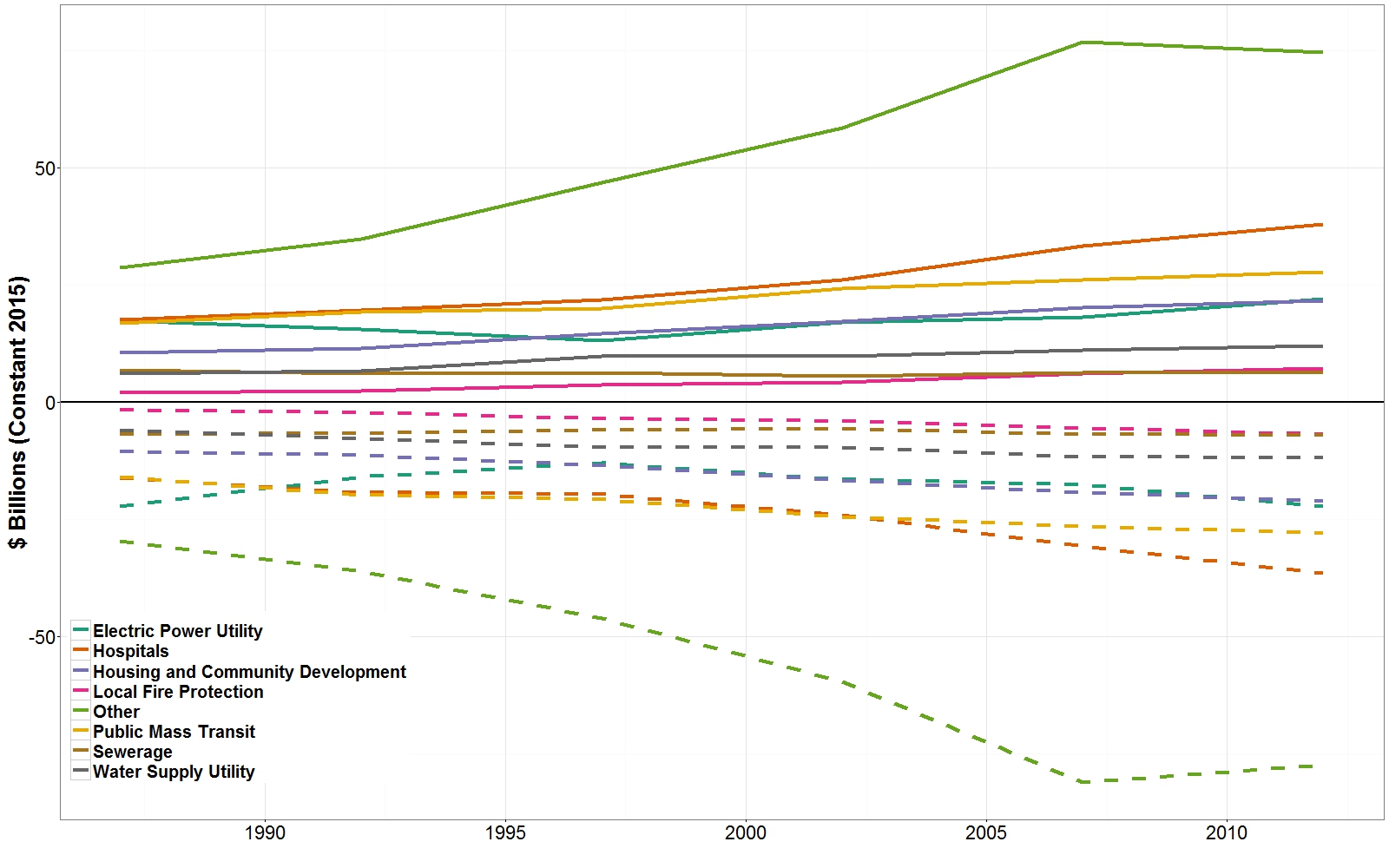
The next figure shows the composition of special districts’ revenues. It shows each revenue source as a percent of total revenues for special districts by type. For example, in 2012, public hospitals derived 77 percent of their revenues from charges and fees. In other words, a typical hospital earns revenue by collecting fees from patients (and patients’ health insurers, including Medicare and Medicaid). Public hospitals levy property taxes (12 percent) and receive federal (4 percent) and state (7 percent) intergovernmental revenues. Utility districts are authorized to deliver electricity to customers and collect fees in exchange.
Revenue Composition of Special Districts (2012)
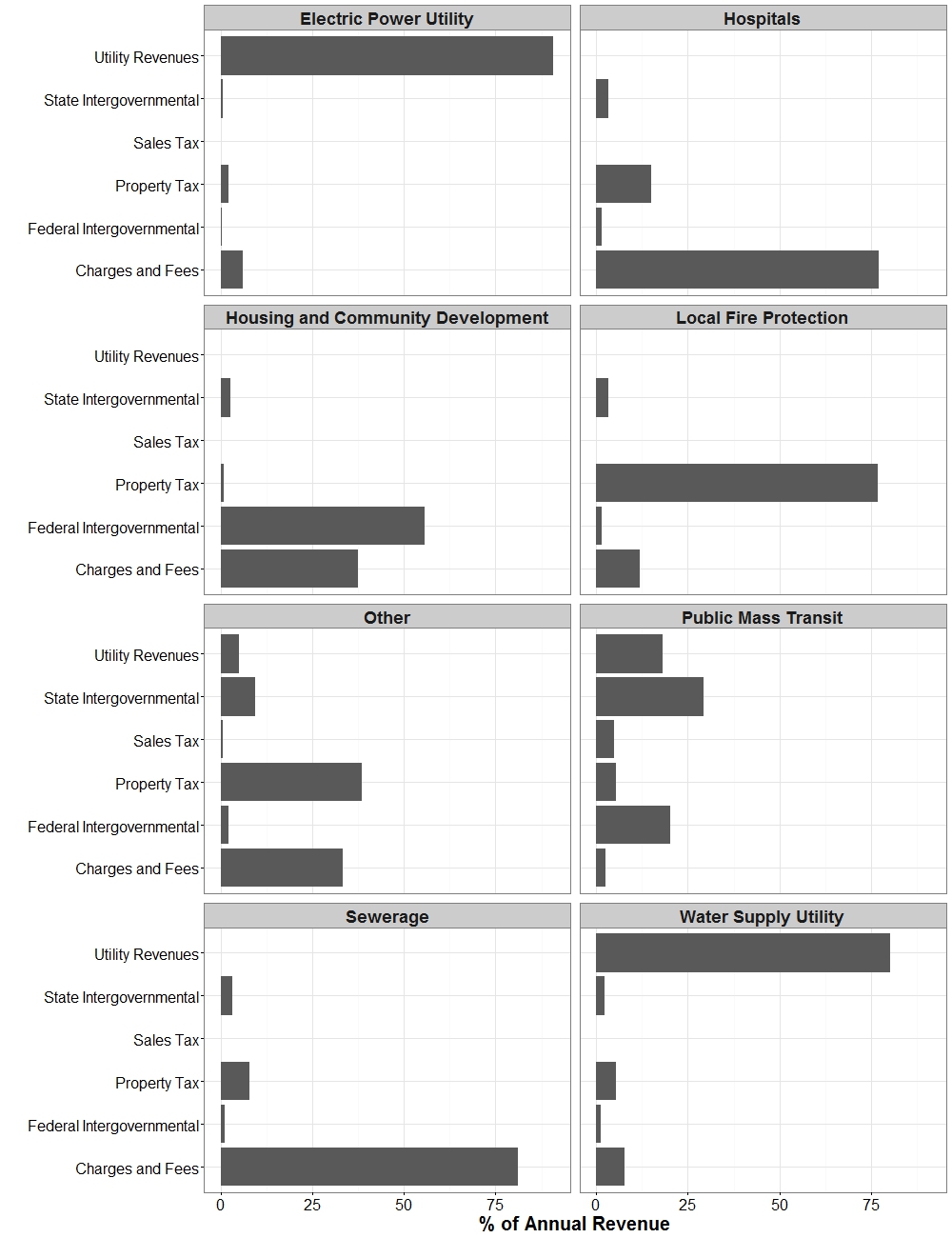
This chart’s key takeaway is that most special districts depend on one or two main revenue sources. This is not a coincidence. State and local legislatures typically grant special districts limited revenue authority, and few can levy a tax or receive funding from the state. In fact, special districts are engaged in business-type activities where they deliver a specific service in exchange for a fee. This is quite different from state and local governments, where taxpayers pay general revenue sources like property and sales taxes and receive general services like public safety and public health.
What accounts for the explosive growth of special districts? Two, sometimes contradictory factors. First, special districts allow for more direct taxpayer control. Suppose citizens receive a service through their municipal or county government, and they wish to change how they pay for that service or how that service is delivered. In that case, they can only affect that change through their city councilmember or other local representatives who must also attend to dozens of other service delivery concerns. With special districts, citizens elect a separate governing body that attends only to that specific service, and they pay taxes or fees dedicated to that service. The relationship between governance, funding, and service delivery is, in concept, much clearer.
Fire protection is a good example. Citizens in unincorporated areas (i.e., areas that fall outside the boundaries of any municipality) often receive fire protection from a county government or nearby municipality. In the event of a fire, they would rather not wait for the county or nearby municipal fire service to arrive. They’d much rather have local firefighters who understand the local terrain and offer services that a municipal or county fire service is less likely to deliver (e.g., wilderness rescue, wildfire prevention, and outreach). So, they create a local fire protection district, pay property taxes specific to that district, and elect a fire protection district board. We see a similar dynamic in service areas like flood control, agricultural irrigation, and parks. It is also quite common in the Western U.S., where local political culture tends to favor populist, local control of government. For example, while Tennessee and Washington have roughly the same population, Tennessee has 347 municipal governments and 475 special districts, whereas Washington has 281 municipal governments and 1,670 special districts.
Special districts have also proliferated because they can help citizens circumvent tax and expenditure limitations. Sometimes those limitations are political. For instance, taxpayers across the country have voted often to move traditional municipal services like libraries and parks from their municipal government to a special district. When these services are delivered through a special district, they have a dedicated revenue source. They need not compete with public safety, roads, water/sewer, and other municipal services for limited tax dollars. And sometimes, those limitations are legal. For example, school districts in many states must get voter approval for new school buildings. Before the district can borrow money to build, voters must approve the additional property taxes needed to pay back that borrowed money. Voters are reticent to support additional property taxes. So, as an alternative, a district can authorize the creation of a school building authority. That authority will borrow money, build the new school building, lease the building to the district, and then repay the borrowed money with the school district’s lease payments. At one point in the early 2000s, nearly half the public school buildings in Texas were financed through this “leaseback” model.
This proliferation presents a variety of trade-offs for governance and accountability. Special districts do offer more local control, but the evidence suggests they often do the opposite. Voter turnout for special district elections is usually among the lowest for all elected offices. Academic research shows that citizens rarely know that special districts even exist and almost never know who they voted for in the last election. So, there is little evidence that special districts offer better democratic accountability. Another practical concern is that the proliferation of special districts has drastically increased the total amount of local government debt outstanding. This raises a variety of concerns about whether local governments are able to repay those debts.
DEFUND THE POLICE
The opening salvo to this chapter is the story of Michael Brown, a teenager and a resident of Ferguson, who was shot and killed by a police officer who was investigating a nearby robbery. The deaths of George Floyd, Breonna Taylor, and other Black Americans have once again raised questions about police training, tactics, and priorities, especially with respect to their interactions with communities of color. One response to these tragedies is calls to “defund the police.” Defunding the police means different things to different communities – but at its core, it is a call for police reform that would divert funds from police budgets to community health, economic development, and other services to address the root causes of crime.
The Defund the Police movement has raised many important questions about how local governments spend money and what that spending says about their priorities. Perhaps most importantly, it’s shown that those priorities can be radically different from one neighborhood to the next. Local government spending on public safety (i.e., policing, fire, and corrections) ranks third behind spending on education and social services. The chart below shows that spending on policing today remains at the level it was in 1959 – even though today’s crime rates are at their lowest point in decades.
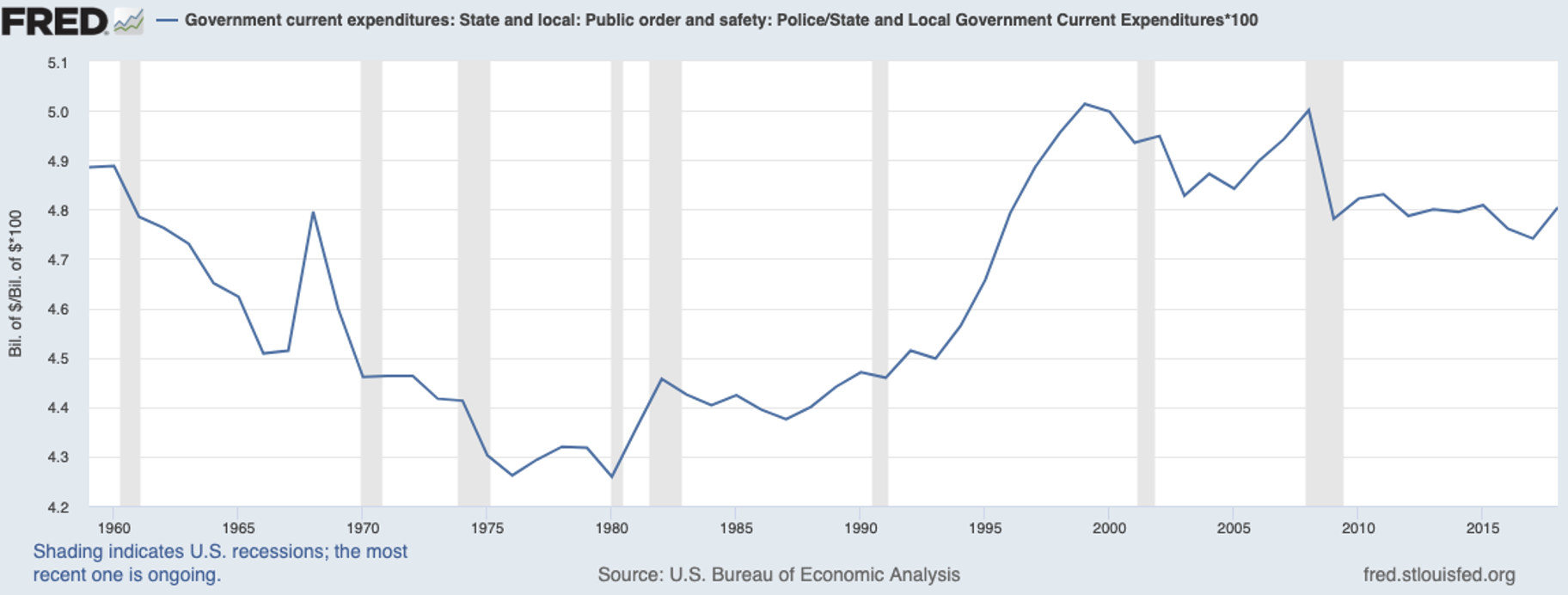
Revenues from the criminal justice system have become an essential part of local government budgets. The DOJ’s formal investigation of the fatal shooting of Michael Brown found that the city’s law enforcement practices were shaped by its focus on revenue rather than on public safety. Ferguson’s practices may have been more aggressive than some other police departments. Still, many local governments have come to rely on fines, fees, and penalties for revenues even though the incidence falls disproportionately on the poor and communities of color. In other words, defunding the police also means, to a degree, defunding other parts of local government.
While much of the public debate has focused on defunding the police in the face of police brutality, few have focused on how ineffective many police departments are at doing what they are supposed to do – solving crime. Data shows that approximately 38 percent of murders, 48 percent of aggravated assaults, 66 percent of sexual assaults, and 70 percent of robberies go unsolved. Even though budgets define responsibilities and can be used to hold agencies accountable, more often than not, police are also asked to respond to everything from loose dogs to disciplining children in our public schools. Police advocates and critics alike agree that “policing” resources are not allocated to their best use.
Now that you have a better grasp of where the money comes from and where it goes, you’ll recognize the complexities in the call for defunding police. One immediate complication is differences in the scale of spending. Many experts have argued that underserved communities need massive investments in public schools and in social services like community health and affordable housing. Recall that local governments collectively spend orders of magnitude more money on schools and social services than they spend on public safety. Because of that, even a massive reallocation of public safety resources would do little to qualitatively increase spending in areas where it’s most needed. For some defund policing advocates, that redirection would symbolize an important shift in priorities, even if the actual impact was minimal. But any serious attempt to address the needs of underserved communities will acknowledge that defunding the police is, at most, a partial solution. Another challenge is to define what services the police will provide with lower budgets and whether some of their existing responsibilities will be shifted to other organizations in the local government. What changes will lead to police using their budgeted resources more efficiently and effectively?
When we put the movement’s goal and tactics in the context of local revenues and spending generally, it is clear that achieving its broader goals requires more than just reallocating police budgets. That will require careful attention to local governments’ overall revenues and spending, what a fiscally sound local government looks like, what it costs to deliver public services, what it means to deliver those services cost-effectively, and how local budget politics and processes reinforce or upend existing policy priorities. Those are precisely the questions you’ll grapple with throughout this textbook.
THE NON-PROFIT SECTOR
Non-profits are big business! According to the National Center for Charitable Statistics, approximately 1.54 million non-profit organizations were registered with the Internal Revenue Service at the end of 2016. Note that not all non-profits are registered with the IRS; therefore, the total number of non-profit organizations in the U.S. is unknown. The sector collectively reported $5.99 trillion in assets and $2.62 trillion in revenues and contributed an estimated $1.05 trillion to the U.S. economy (5.6 percent of the nation’s GDP).
Public charities are the largest category of more than 30 types of tax-exempt organizations (totaling1.08 million in 2016) – a majority of which are small, therefore, not required to file tax forms with the IRS (i.e., Form 990, Form 990-EZ, or Form 990-PF).
The figure below presents an analysis of public charities by size. Just over three-quarters of reporting public charities – i.e., those reporting expenses of less than $1 million – altogether account for 2.1 percent of total expenses. In contrast, charitable organizations reporting $10 million or more in revenues reported the largest share of expenses (88 percent) even though they were a smaller share of the sector (5.3 percent).
Number and Expenses of Public Charities (as a Percentage of All Reporting Public Charities and Expenses)
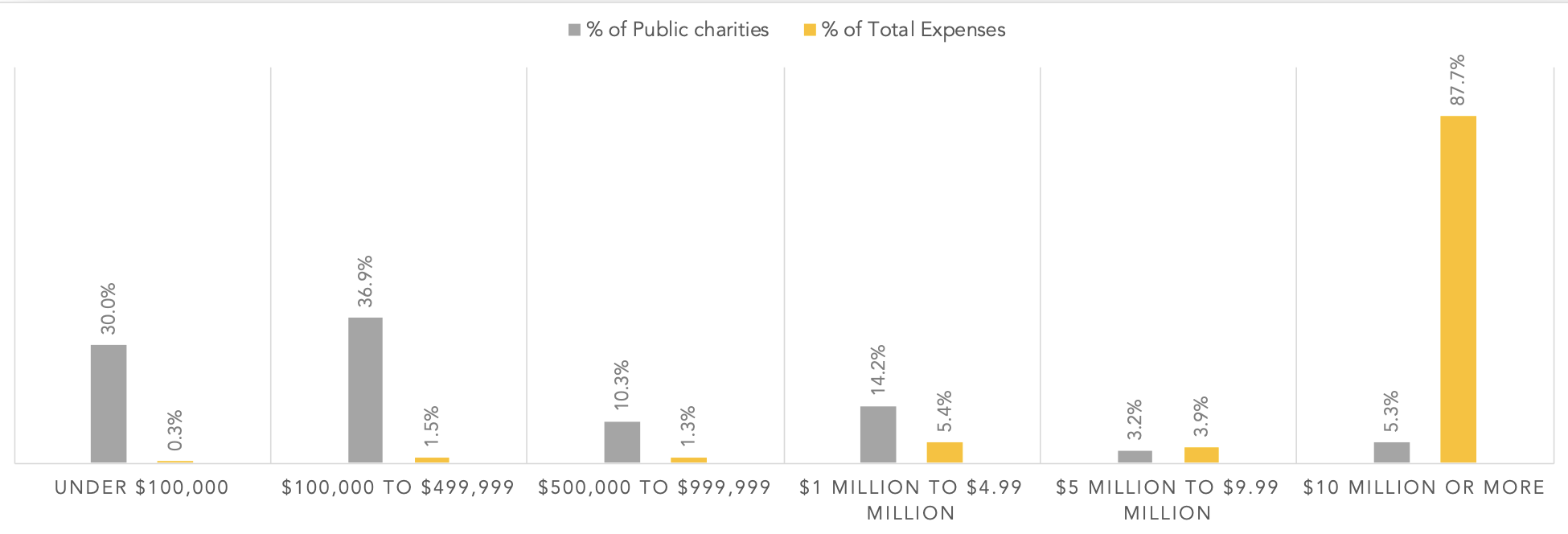
To understand where non-profits get their money and where their money goes, you must first understand the many different types of organizations that comprise the “non-profit sector.” The table and charts below illustrate some of these differences. A few key trends stand out. Healthcare organizations have an outsized role in the sector. Even though they represent 12 percent of organizations, they account for 59 percent of the sector’s revenues and 43 percent of assets. The Kaiser Foundation Health Plan, together with Kaiser Foundation Hospitals, for example, reported $68 billion in expenses at the end of FY 2016. That has since grown to $97 billion at the end of FY 2022.
Education non-profits (including private schools, universities, and parent-teacher associations) were 17 percent of non-profits but were an oversized share of the sector’s assets – 33 percent. That includes not only the physical assets (e.g., academic buildings and student housing) but also financial investments. The President and Fellows of Harvard College is a permanent endowment that supports professorships, financial aid, and student activities at Harvard University. At the end of FY 2021, the university reported $60 billion in investments ($72 billion in total assets) – the largest of any private university. The Bill and Melinda Gates Foundation, the largest U.S. foundation, reported $67 billion in long-term investments and $68 billion in assets.
These non-profits defy the conventional wisdom that “non-profit” means “not profitable.” How can an organization be that large and profitable yet remain “non-profit”? That’s because the term “non-profit” refers to the organization’s tax status, not its business model. By law, non-profits do not pay federal, state, or local taxes on their net income – except UBIT – that is, unrelated business income tax paid on income earned on activities that are not substantially related to furthering the exempt purpose or the organization. They also receive tax-free charitable donations from individuals and corporations. We grant them these benefits because they deliver goods and services that would benefit the public. Most non-profit hospitals accomplish this by offering free or low-cost healthcare to people who can’t afford it. As long as they provide that service, there’s little restriction on how much profit they can earn. For public sector organizations, profits are not central to resource allocation. However, as you’ll see in Chapters 2 and 3, profits are essential to their long-term financial health.
Ten Largest Public Charities by Subsector, 2016
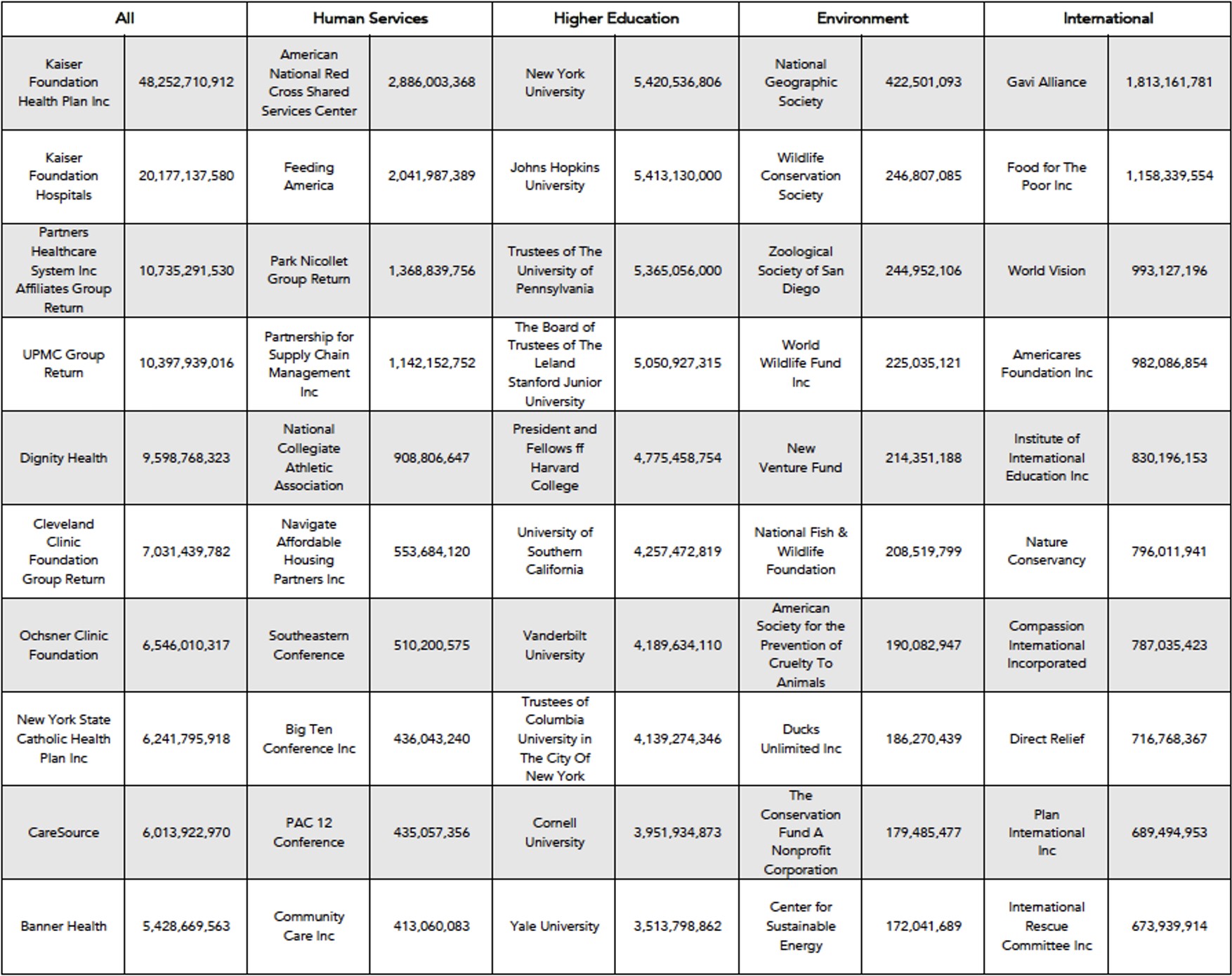
Human service organizations (including food banks, homeless shelters, and youth and family service social service organizations) were the most common type of non-profit (35 percent of public charities). However, they reported a significantly lower share of the sector’s revenues and assets (12 percent and 10 percent, respectively). They are also more likely to rely on individual contributions, foundation grants, and government contracts. As you’ll see in Chapter 3, human service organizations do not report sizeable investments or endowments, and given the demand for services, they are more likely to report operating deficits.
The largest human service organizations – American Red Cross, Feeding America, Park Nicollet Group, Partnership for Supply Chain Management Inc., Navigate Affordable Housing Partners Inc., and Community Care – provide access to food, affordable housing, and medical care. However, intercollegiate sports associations (i.e., the NCAA, SEC, and PAC 12) are registered as non-profits and among the ten largest human service organizations!
Public Charities Revenues and Assets by Subsector, 2016
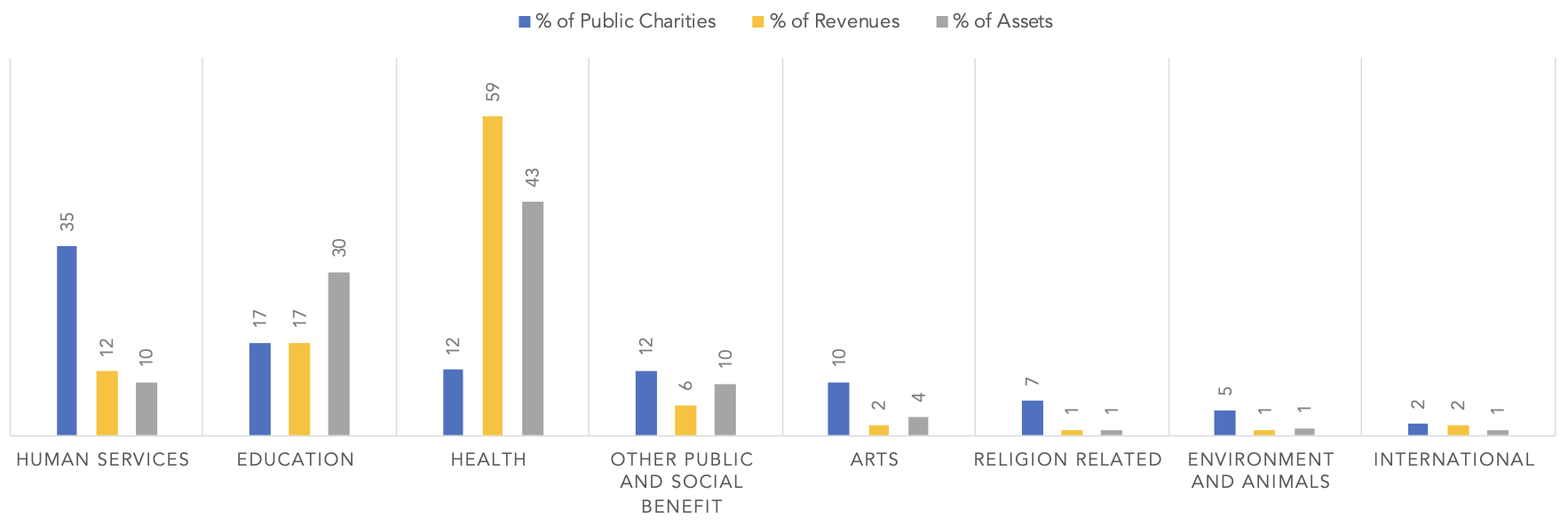
Non-profits provide a staggering variety of services. Many of those services are not unlike governments – they conserve land for future generations, manage affordable housing programs, and provide pro bono legal services for people experiencing poverty. Like governments, a sizeable portion of their budget is spent on employee wages and benefits. And like governments, the sector is comprised of thousands of small organizations but dominated by a handful of larger organizations.
However, unlike governments, contributions are the primary source of revenues for most non-profits. Recall from our earlier discussion: public charities reporting expenses of less than $1 million were three-quarters of the sector. The chart below shows that contributions were a significant revenue source, particularly for non-profits reporting $1 million or less in expenses. Those reporting revenues of more than $10 million were less reliant on contributions and more reliant on program service revenues, including tuition payments to revenues from sales of specialty goods, memberships, and patient revenues (including Medicare/Medicaid). Many remain skeptical that these large non-profits need or deserve tax exemption.
Public Charities Revenues by Source and Size, 2016
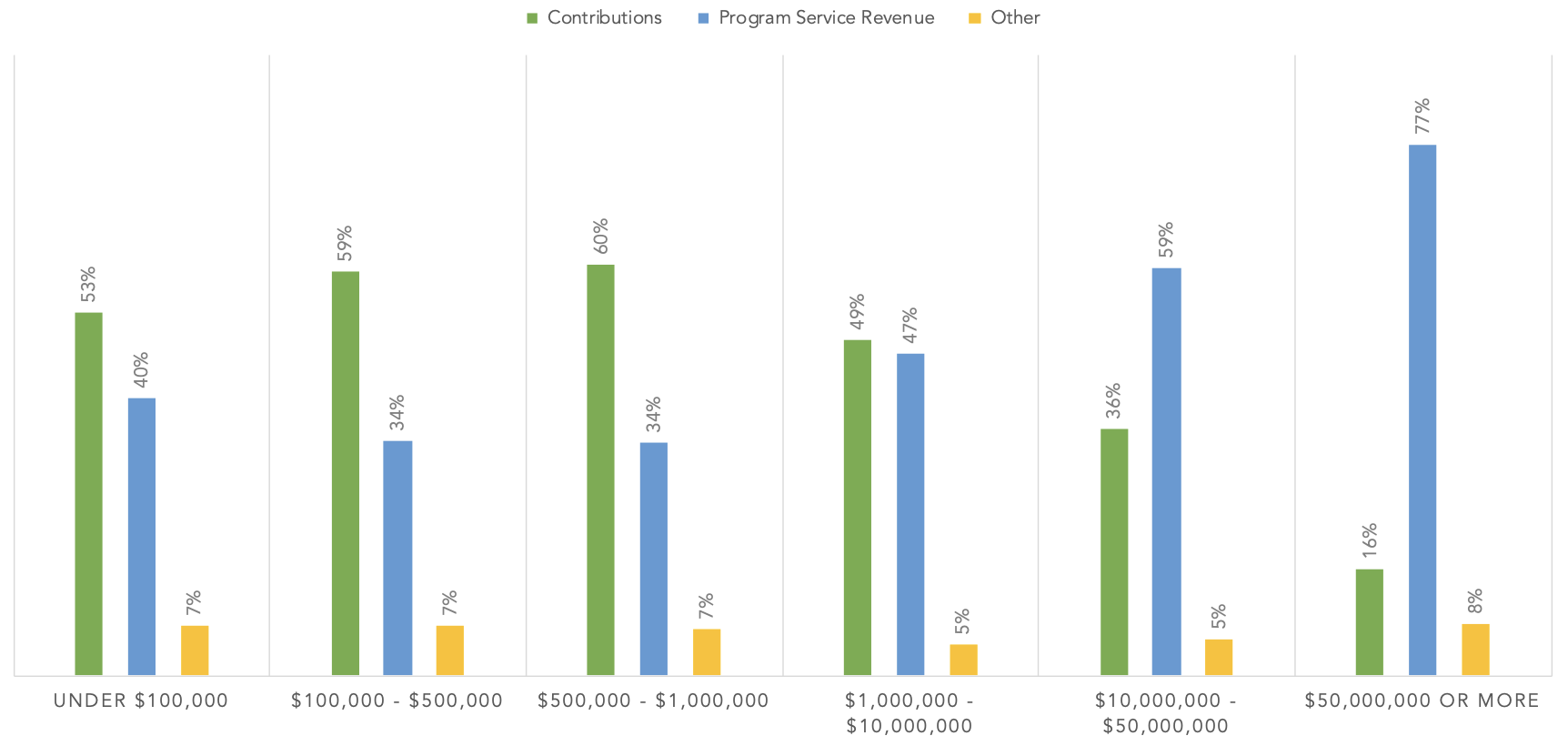
Federal, state, and local governments are an essential source of revenue for the sector. More than one-third of non-profit revenue is directly connected with the government – either as a grant, contract for services, or reimbursement for services provided (e.g., Medicaid/Medicare).
Government revenues are not distributed evenly, with significant variation based on sector and the size of the organization. This suggests that many non-profits are not necessarily independent entities with their own mission and organizational capacity but rather low-priced government contracts. In later chapters, we explore the advantages, disadvantages, and criticisms of this part of the non-profit-government nexus.
Governments also support the non-profit sector through a powerful tax preference. The federal government and most state governments offer a tax deduction for charitable giving. Donors give to non-profits for many reasons. Perhaps they like a non-profit’s mission or strategy. Maybe they or someone they know received that organization’s services. Or perhaps the decision to give had a lot to do with tax planning. When a donor gives to a non-profit, that donor’s taxable income is reduced by the amount of that gift, so, for many individuals and corporations, in addition to supporting their favorite non-profit, charitable giving can also reduce their income tax liability, sometimes by up to 50 percent. The U.S. Congress’ Joint Committee on Taxation estimates that the federal government’s charitable deduction costs about $50 billion annually in foregone revenue.
There is considerable controversy around the charitable deduction. Some believe it only benefits the wealthy and does little to encourage giving. Critics argue that big philanthropy, more than ordinary small donations, is wealth-derived power with minimal democratic controls and civic obligations (Rob Reich (2019) “Just Giving”). Philanthropy perpetuates vast differences in privilege and then tasks the privileged with improving the system (Darren Walker (2015) “Toward a New Gospel of Wealth”). Perhaps we should stop being grateful for philanthropy and instead direct our skepticism at their activities.
NON-PROFIT PILOTS – PAYMENTS IN LIEU OF TAXES
In every state, charitable non-profit organizations, including private universities, hospitals, museums, and churches, are exempt from property taxes. The impact of the property tax exemption largely depends on the degree of reliance on property taxes as a revenue source and real estate holdings of charitable organizations in the jurisdiction.
Yale University, for example, is New Haven’s largest employer. The university’s real estate holdings, including academic buildings, student housing, research facilities, and a sprawling hospital complex – are all property tax-exempt. In fact, 56 percent of New Haven’s taxable property tax base is exempt. Yale owns a significant proportion of the exempt property.
Cities like Boston, Philadelphia, Pittsburgh, and Los Angeles face the same challenge. Their largest employers include private universities, non-profit hospitals, and cultural organizations, all of whom own valuable real estate – all of which is tax-exempt. While these organizations are economic engines for these cities, the growth in commercial activities by non-profit organizations has raised questions about their property tax exemption. More importantly, the substantial reduction in the taxable base has led to higher property tax rates for residents.
PILOTs (or payments in lieu of taxes) are payments made by tax-exempt non-profit organizations in place of property taxes. PILOT payments are structured as either one-time or long-term contracts with annual payments at a fraction of the locality’s foregone property tax revenue.
PILOTs are often the result of tense negotiations. Consider the case of the City of Pittsburgh and the University of Pittsburgh Medical Center. In 2013, the city sued the UPMC. The goal of the lawsuit was to strip UPMC of its tax-exempt status. According to the City’s complaint, UPMC did not deliver adequate charity care to justify its tax-exempt status, made no payments in lieu of taxes, and paid its executives lavish compensation packages. Had the City won in court, it planned to impose a 0.55 percent income tax on wages earned by UPMC employees. UPMC counter-sued, claiming it had been unfairly singled out among Pittsburgh’s dozens of large tax-exempt organizations. The city dropped its suit in July 2014.
Source: J. Brian Charles (2018) “Towns Gowns and Real Estate” Governing Magazine and Daphne Kenyon and Adam Langley (2010) “Payments in Lieu of taxes: Balancing Municipal and Non-profit Interests” Lincoln Institute of Land Policy.
- Wealth inequality is even greater. The top 10 percent of households – those with at least $1.2 million in net worth – own in aggregate 77 percent of wealth in America, whereas the bottom half of families (approximately 63 million families reporting a net worth of $97,000 or less) own in aggregate one percent of wealth (Source: Ana Kent, Lowell Ricketts, and Ray Boshara “What Wealth Inequality in America Looks Like: Key Facts & Figures” Federal Reserve Bank of St. Louis). ↵
- Adjusted for inflation, $200,000 in 1962 is equivalent to $1.7 million today. ↵
- The first debt limit was established in 1917 to make it easier to finance mobilization efforts in World War I. Before that, Congress had to authorize each bond issue. ↵
- The federal government borrows money by issuing treasury bills, notes, bonds, nonmarketable securities, and other securities. Treasury bills have a maturity of three months up to 12 months. Treasury notes have maturities of two years to ten years. Treasury bonds mature in 10 years up to 30 years. Nonmarketable securities include securities issued to state and local governments and federal trusts (e.g., Social Security). Floating rate notes are short-term investments (mature in two years or less) that have an interest rate that may change (or float) over time, while Treasury Inflation-Protected Securities (or TIPS) are indexed to inflation to protect investors from a decline in the purchasing power of their investment. ↵
- The federal government officially recognizes the sovereignty of 573 Indian tribes in the contiguous 48 states and Alaska. U.S. territories (Puerto Rico, Guam, Northern Mariana Islands, U.S. Virgin Islands, and American Samoa) are self-governing, and each has a non-voting member of the House of Representatives. We’ve not included a discussion on the revenue structure or spending priorities of these governments in this edition of the text. ↵

